
Бесплатный фрагмент - All sciences. №6, 2022
International Scientific Journal
THE GREAT SCIENTIST MUKHAMEDIEV AULIYAKHON MUKHAMEDOVICH
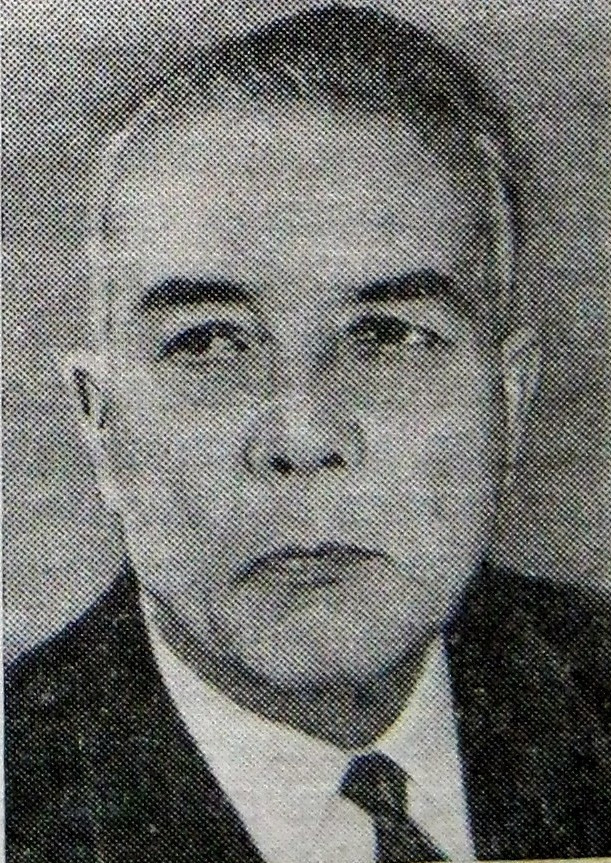
The famous scientist-hydrobiologist, one of the founders of the fisheries industry in Uzbekistan and in the republics of Central Asia, academician of the Academy of Sciences of Uzbekistan Auliyakhon Mukhamedovich Mukhamediev, was born on August 16, 1906, in Margilan. His father Mukhamedkhoja Dadakhodjaev, who taught at the Ferghana Russian-Native School, died in 1913 and the seven-year-old Avliekhon learned the hard work of finding a livelihood very early. By 1917, he acquired the specialty of a khan-atlas weaver and worked for hire under the guidance of his elder brother Mukhamediev Valikhon, having independently mastered the course of secondary school and received a certificate of maturity, in 1920-1927 he worked in the secretariat of the county executive committee, then in the department of public education of Margilan.
In 1928-1929, he studied at the preparatory department of the Uzbek State University in Samarkand, and from January 1, 1930, he became one of the first students of the Central Asian State Pedagogical Institute, which reopened in Ferghana, where boys and girls from Uzbekistan, Kazakhstan, Kyrgyzstan, Turkmenistan and Tajikistan studied — it was the first university that trained personnel teachers for schools throughout the region. Until 1940 . Almost the entire staff of the teachers of the Fergana Pedagogical Institute (present-day Fergana State University) consisted of professors and associate professors who arrived from Moscow.
At their lectures, A. Mukhamediev delved into the basics of physics, mathematics, chemistry and biology with great interest; among them, the lectures of Professor Sergei Vasilyevich Averintsev, a world—renowned hydrobiologist, were especially interesting; despite the fact that classes were held in Russian and despite the professor's strict requirements for students, his lectures on zoology they were very exciting, and therefore Auliyakhon Mukhamediev decided that he would certainly become a zoologist.
Since 1936, at the invitation of the professor, he becomes an assistant at the Department of Zoology of the Fergana Pedagogical Institute and gets acquainted with the methods of hydrobiological research, goes on the first expeditions to reservoirs, collects zooplankton — microscopically small crustaceans — the main representatives of the animal world of rivers, lakes, ponds and rice fields of the Fergana Valley. Another, very significant mentor A. Mukhamediev was his scientific adviser Arvid Liboryevich Bening, professor of the St. Petersburg Zoological Institute (ZIN) of the Russian Academy of Sciences, with whom he constantly communicated, as well as with other scientists — founders of hydrobiological science, as well as with professors of the Central Asian (now National) University of the Republic of Uzbekistan A. L. Brodsky, T. Z. Zahidov, by A. T. Tulaganov and many other specialists. By the beginning of the Second World War and the evacuation to Central Asia of a large number of people from the European part of the country, A. Mukhamediev is working on the implementation of the results of his research into the creation of the rice industry in Uzbekistan.
A little earlier, back in the 1930s, the results of his experiments and observations on the reservoirs of the Zarafshan oasis and the Ferghana Valley were the basis for the development of methods for combating malaria and acclimatization of gambusia - fish imported from the southern states of the USA. In 1942, based on the material of the first studies of the complex of crustaceans of the rice fields of the Fergana Valley, he defended his PhD thesis, and became the head of the Department of Zoology and General Biology of the Fergana Pedagogical Institute, which he led for more than 40 years.
In the 1950s, while in the doctoral program of the ZIN of the Academy of Sciences of the Russian Federation, he continues an extended study of the reservoirs of the Fergana Valley, closely cooperates with colleagues from the Institute of Botany, the Institute of Zoology of the Academy of Sciences of Uzbekistan, as well as with scientists from the ZIN and other academic institutions. In 1958, he successfully defended his doctoral dissertation in ZINA on the hydrobiology of the reservoirs of the Fergana Valley. The typology of rice fields developed by him became the basis for the development of rice farming in the countries of Southeast Asia, where, in addition to rice, commercial fish is also obtained on the basis of the method developed by him.
In 1960, he received the academic title of professor and organized the opening of a postgraduate course in the specialty "hydrobiology" at the Department of Zoology and General Biology of the Fergana Pedagogical Institute. During the period of operation of this scientific school, 26 candidate dissertations on hydrobiology and ichthyology of reservoirs of Uzbekistan, Azerbaijan, Kazakhstan, Kyrgyzstan, Tajikistan, Turkmenistan and Karakalpakstan, as well as 4 doctoral dissertations on fish fauna were defended under his direct supervision. At the same time, he oversees the activities of the Department of Hydrobiology and Ichthyology of the Institute of Zoology of the Uzbek Academy of Sciences.
In 1968, A. Mukhamediev was elected an academician of the Academy of Sciences of the Republic. From that moment on, he begins large-scale activities within the entire region of Kazakhstan and the Central Asian republics: he is elected chairman of the regional branch of the Ichthyological Commission of the Ministry of Fisheries of Russia, chairman of the Uzbek branch of the Hydrobiological Society, as well as a member of other scientific divisions of the All-Union Academy of Sciences; at the same time, he was the regional coordinator of the UNESCO international program "MaB" for countries Central Asia.
In 1968-1988, Academician Auliyakhon Mukhamediev was the main initiator of the traditional conferences "Biological foundations of Fisheries in Kazakhstan and the Republics of Central Asia", which greatly contributed to the expansion of scientific relations of the Department of Zoology and General Biology of the Pedagogical Institute with the Faculty of Biology of Moscow State University, with ZIN, the Institute of Evolutionary Morphology and Ecology of Animals and with the Baikal Limnological Station of the Russian Academy of Sciences, with Kazan and Tomsk State Universities, with the Institute of Hydrobiology of the Academy of Sciences of Ukraine, academic Institutes of Uzbekistan, Azerbaijan, Tajikistan, Turkmenistan, with the Kazakh Scientific Research Institute of Fish Farming, Kazakh State University, Issyk-Kul Biological Station of the Academy of Sciences of Kyrgyzstan, Osh Pedagogical Institute (now Kyrgyz-Uzbek University), as well as with many scientific institutions and universities.
Based on the results of scientific research, he developed the basics of the theory of zooplankton transport by air masses, as well as the provisions of the typology of reservoirs in Central Asia. He has published more than 125 scientific papers, including such monographs as "Hydrobiology of reservoirs of the Ferghana Valley", "Crustaceans of reservoirs of the Ferghana Valley", as well as textbooks "A short course in invertebrate Zoology" and "Invertebrate Zoology" (published in the state language) have not lost their significance today.
His scientific ideas and developments will undoubtedly serve the cause of organizing a cluster of fish farming, creating a digital economy of Uzbekistan and will contribute to increasing the scientific prestige of our country at the world level. So, the brilliant scientist and researcher ended his life on October 22, 1988, leaving a huge contribution to the amazing zoological science, serving as a real example for all future generations.
Mukhammadiev Muzaffar Auliyakhanovich,
Candidate of Biological Sciences, Associate Professor of the Department of Zoology and General Biology, Faculty of Natural Sciences, Fergana State University.
PHYSICAL SCIENCES
USING THE PROPERTIES OF AN IDEAL FLUID IN SMALL HYDROPOWER
Abdurakhmonov Sultonali Mukaramovich
Candidate of Physical and Mathematical Sciences, Associate Professor of the Faculty of Computer Design Systems of the Fergana Polytechnic Institute
Ferghana Polytechnic Institute, Ferghana, Uzbekistan
Аннотация. Большие гидроэнергетические установки чаще всего используют изначальную конструкцию создания платины для увеличения напора входящей жидкости, что приводит к увеличению общего выхода энергии. В статье рассмотрено теоретическое предположение об использовании подобного метода увеличения скорости самого потока при помощи свойства идеальной жидкости из закона Бернулли и формулы Торричелли.
Ключевые слова: водный поток, напор, ускорение, скорость свободного падения.
Annotation. Large hydropower plants most often use the original design of creating platinum to increase the pressure of the incoming liquid, which leads to an increase in the total energy output. The article considers a theoretical assumption about the use of such a method of increasing the velocity of the flow itself using the properties of an ideal fluid from Bernoulli’s law and Torricelli’s formula.
Keywords: water flow, pressure, acceleration, free fall velocity.
For large hydropower plants, technologies for creating dams are often predominant, where water is brought to a state close to static in relation to the total volume, after which water is passed into a channel located as low as possible below the water level. The presence of such a fluid input allows the mass to be given additional velocity due to the potential energy, which is converted into kinetic energy.
The proof of this statement follows the relation (1), from which both the potential energy (2) and the kinetic energy (3) can be deduced, then if they are equal (4), we can conclude for the velocity (5).

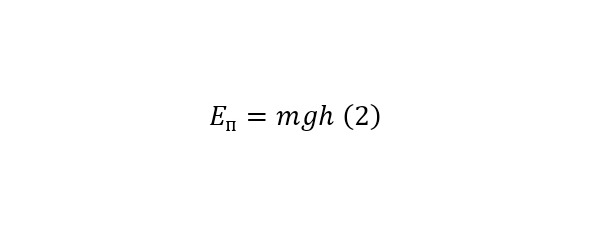

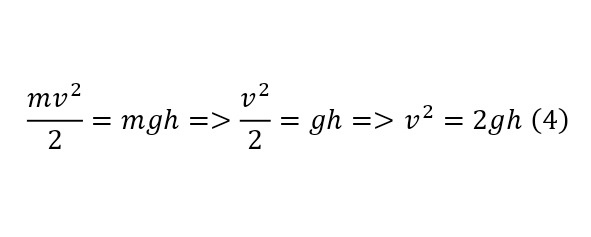

But in order to indicate the relation of this conclusion not only to ordinary bodies with high density, that is, to solids, but also to liquids, it is enough to cite Bernoulli’s formula (6), which is quite valid for liquids and the conclusion of the same formula from it (7—8).
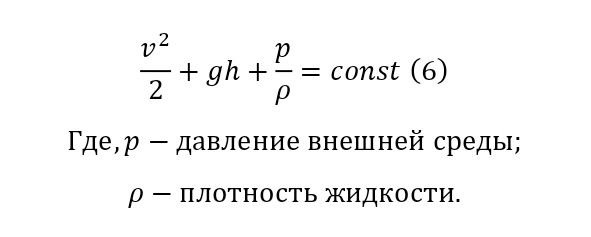

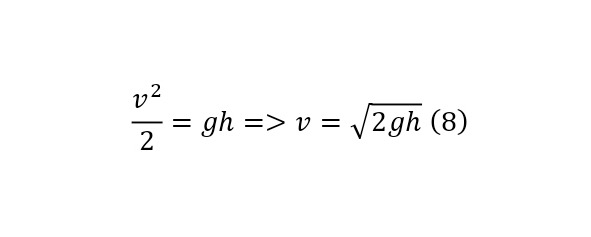
From this, it is possible to obtain a secondary additional vector, which most often prevails and makes it move under the pressure of the water itself, and the vector of the inflow velocity into the reservoir itself is most often extinguished. But when the situation is with conventional small hydropower plants, the situation is different here, since the braking capacity of the available small volume in the «dam» is not so high and is determined by the coefficient of friction of water on water, so to speak. That is, each segment, the reduction occurs precisely by the specified energy coefficient (9).
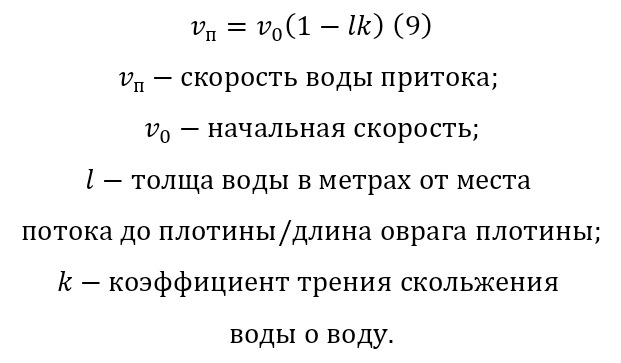
This velocity vector is summed with the resulting velocity vector due to pressure (8) at right angles forming the resulting vector (10).
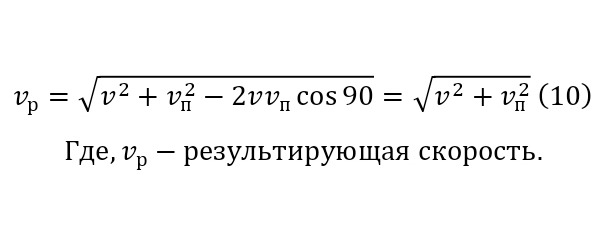
The resulting output vector will logically be larger than the initial velocity vector (11), so it can be concluded that the use of dams in the design of small hydropower plants is quite appropriate technology.
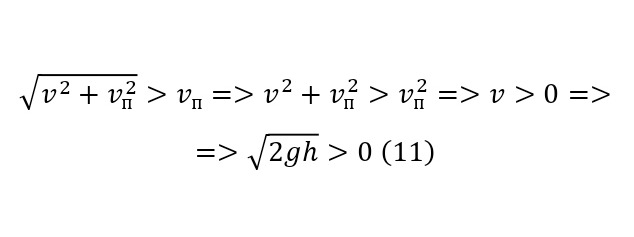
That is, no matter how small the height of the dam and its difference between the outlet of the flow and the water level, the effect, although insignificant, will be provided. It is also interesting here to determine the dependence of the initial velocity itself and the resulting vector (12).
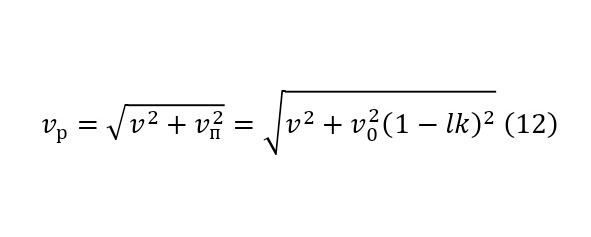
This dependence was deduced because even the initial velocity itself is not quite simple and due to the fact that the lower cavity of the ravine for the "reservoir" should be made in the form of a slope. Along with a decrease in coefficient depending on the length of this path according to (9), the initial velocity will increase, since to the initial velocity before entering the "reservoir", at which the flow had potential energy, the kinetic energy into which this potential is converted, that is, the same principle applies (1-5), but at in this case, the angular coefficient acts.
And if, since again this potential downward vector is also at an angle of 90 degrees to the main initial vector, their summed vector will be determined by (13), creating a dependence for the initial velocity on the initial one in the next location.
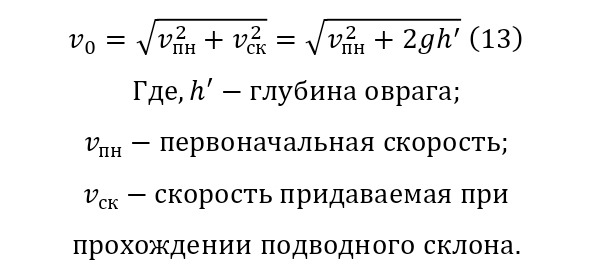
From where it is true (14).

And it is important to take into account that (13) together with (14) acts only with a flat slope of the ravine itself, not counting the coefficient of friction, in the case of its calculation, an additional coefficient is included in (14), exactly as in other cases, for implementation, but this coefficient is determined empirically.
In the case of (13) and (14), the previously described (12) changes as (15).
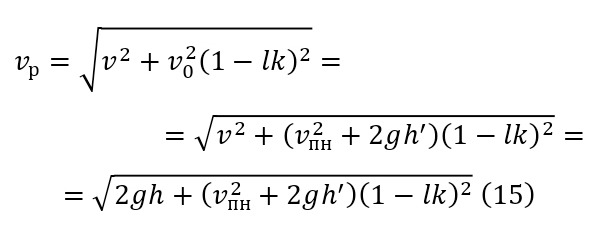
Thus (15) can be considered a full-fledged formula for the action of a straight slope at the bottom of a ravine. If there are several vectors, it is advisable to use (16), for the simple reason that several vectors will not come from the same direction, because then they can be combined into one. And the vectors may be different due to the presence of additional turns, large irregularities and similar insignificant reasons.
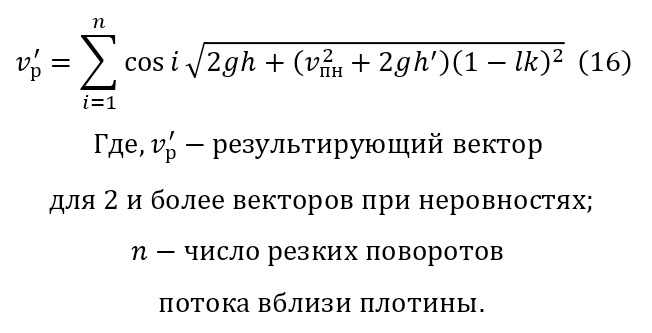
The final touch is only the introduction of the coefficients mentioned earlier, namely, the coefficients of a kind of viscosity (18), depending on the coefficient of resistance of movement in the flow (17).
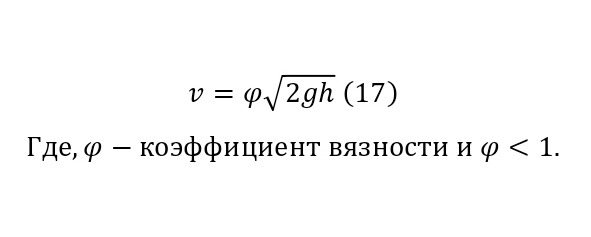
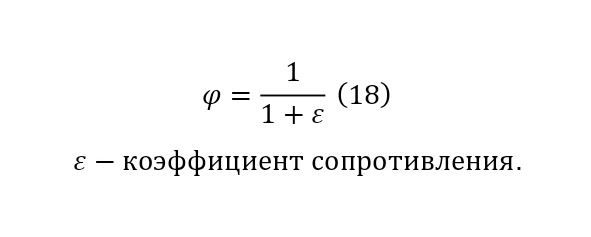
This type (17) of formula (8) was proved and described by the Italian scientist Evangelista Torricelli in 1643, and later it was shown that this formula, as already mentioned, is a consequence of Bernoulli's law.
In conclusion, it can be noted that the development of hydropower has a very progressive character, which pleases. And this development requires more and more new technologies, among which one of the best may be the technology of using a «small reservoir» or an artificial moat with an inclined bottom to increase the efficiency of the entire hydropower plant.
Used literature
1. Evangelista Torricelli. De motu aquarium // Opera Geometrica. — 1644. C. 191. «Aquas violenter erumpentes in ipso eruptionis puncto eundem impetum habere, quem haberet grave aliquod, sive opsius aquae gutta una, si ex suprema eiusdem aquae superficie usque ad orificium eruptions naturaliter cecidisset».
2. Zinoviev V. A. Brief technical reference. Volume 1. — M., Gosizdat, 1949. — p. 362.
3. Savelyev I. V. Course of general physics. Volume 1. Mechanics, molecular physics. — M., Nauka, 1987. — p. 251.
SAVING ELECTRICITY GENERATION AT HYDROELECTRIC POWER PLANTS
Dodobaev Yusubjon Tadjibayevich
Doctor of Economics, Professor
Yuldashev Muminjon Shakirjonovich
Honorary Professor of Ferghana University, Doctor of Economics
Ferghana Polytechnic Institute, Ferghana, Uzbekistan
Аннотация. Мақолада гидроэлектростанцияларнинг самарадорлигини ортириш бўйича фикрлар юритилинган. Сув ресурсларидан комплекс фойдаланиш хақидаги мулоҳазалар кирилиган бўлиб, шу билан биргаликда гидротармоқларда транспорт муаммосини ҳал қилишга катта ҳисса қўшилинган.
Калит сўзлар: ГЭС, самарадорлик, сув ресурслари, электр энергияси, ирригация, дарё транспорти, рекреация.
Аннотация. В статье рассматривается эффективность гидроэлектростанций. Была введена обратная связь по комплексному использованию водных ресурсов, и в то же время был внесен значительный вклад в решение транспортной проблемы в гидравлических контурах.
Ключевые слова: ГЭС, эффективность, водные ресурсы, электроэнергия, орошение, речной транспорт, рекреация.
Annotation. The article discusses the effectiveness of hydroelectric power plants. Feedback on the integrated use of Water Resources has been entered, and at the same time a significant contribution has been made to the solution of the transport problem in hydraulic circuits.
Keywords: GES, efficiency, water resources, electricity, irrigation, river transport, recreation.
The high efficiency of electricity generation at HPPs is determined by a number of factors, including:
* Permanent restoration of natural resources;
* High labor productivity when using;
* Low cost of electricity produced at the HPP;
* Integrated use of water resources for energy, irrigation, river transport, flood control, water supply, recreation and other purposes;
· The presence of low etiology in relation to complex technological equipment.
It is extremely important that the frequency of industrial damage arising from the use of hydroelectric power plants, including deaths, is significantly less compared to thermal power plants based on the amount of electricity produced in 1 kWh (taking into account fuel extraction and supply enterprises).
The saving of labor resources when using hydroelectric power plants is due to the following, including:
Incredibly high labor productivity compared to TEs;
high level of production automation;
the absence of labor costs for the extraction, supply, processing and disposal of fuel waste and, as a result, the number of working personnel used in the use of hydroelectric power plants will be approximately 12-15 times less than the number of working personnel at alternative facilities. The high economic efficiency of hydropower is due to the lack of a fuel component of electricity, slow wear of fixed assets, relatively low cost of wages, and the perfection of the technological process.
Integrated use of water resources. In the hydropower industry of the Republic of Uzbekistan, the reconstruction of transport routes in river networks, irrigation, industrial and municipal water supply and the development of fisheries are of great importance due to the reduction of the risk of major floods.
Integrated waterworks make a great contribution to solving the transport problem.
Reservoirs that appear during the construction of hydroelectric power plants lead to the fact that large areas of land are covered with water. Hydroelectric power plants account for a total of 1.2 million tons of destructive floods in the republic. close to hectares, with advanced development, multi-million residents help to reliably protect residential areas, as well as solve complex social and environmental problems.
1. Environmental problems
Reducing air pollution, especially carbon oxides, and preventing the "greenhouse effect" on the planet have become one of the problems of universal scale. The Republic of Uzbekistan also contributes to their resolution. One of the ways to reduce emissions in the energy sector is to develop areas without carbon fuels. Hydropower is an absolutely clean direction in this regard. In 2020, the electricity generated by hydroelectric power plants allowed to reduce electricity emissions by a quarter.
The technological process of hydropower production is environmentally hooligan. In the normal condition of the equipment, hydroelectric power plants practically do not emit harmful emissions into the environment. At the same time, the construction of hydropower facilities, in turn, will not show its impact on the environment.
During the construction of hydropower facilities, there is a complex impact on the environment. Reservoirs have the most serious effect — their appearance affects the ecological balance of soils and biocenoses. The effects shown can be both positive and negative.
The impact of reservoirs on the environment depends on their geographical location and categories (mountainous, foothill, plain), geological structure and hydrogeological determination of their banks with a channel, area, shape of appearance, size, depth of water discharge, system of use and other conditions.
As a result of the positive influence of reservoirs as flow coordinators, it becomes important to prevent water shortages for agricultural crops in the summer.
With the activation of natural processes in certain areas of the territories adjacent to them, after the creation of reservoirs, recreational changes occur in the landscapes, recreational zones and ecotourism are formed.
It is possible to list the following other aspects of the impact of reservoirs on the environment.
Floods in the upper part. In flooded areas, there is an increase in the groundwater level, and as a result, the land becomes swampy and unsuitable for agricultural use.
Changes in coastal forms the process of coordinating the flow and the rise and fall of water levels in the reservoir, which occur with this ratio, cause changes in the shape of the bottom with the coastal relief, which, in turn, reduces the size of the reservoir, leading to the accumulation of various rocks in it, the appearance of underwater shoals and the appearance of
Hydrological system. The process of reservoir construction and coordination of the water flow itself in the upper and lower parts of the basins causes changes in the gm hydrological system. Due to the expansion of the window area of the water surface, the volume of water evaporation increases sharply, resulting in the consumption of non-returnable water from the river. The hydrological system of the river is changing.
Climatic conditions. Changes in the flow of water and air, the appearance of waterlogged soils, shallow areas, well warmed by the sun at a depth of 1-1.5 m of reservoirs, create specific climatic conditions.
The influence of reservoirs on fauna (wildlife). All animals in the flood zone migrate to the territory marked by a high level. At the same time, their species composition and number are reduced in accordance with the rule. In some cases, reservoirs are the reason for the enrichment of fauna with new species of birds swimming in the water, fish and flora adapted to wet conditions.
Impact on the fish farm. It should be noted the following, namely:
The construction of a hydroelectric dam prevents the movement of fish to natural mating sites, in some cases fish-breeding devices do not always work satisfactorily;
the requirements that fishing imposes on the watercourse system turn out to be completely opposite to the tasks of coordinating flows, that is, the purpose of creating a reservoir — during the spring flood, shallow areas of the basin are drained at an earlier discharge of water, which negatively affects the mating of fish in the upper part of the reservoir daily
In order to create optimal conditions for fish mating, the transfer of water to the lower part of the pool is carried out subject to strict compliance with the requirements of fishing. In cases where it is possible to prevent damage, it is planned to build compensatory (covering) fish farming facilities (fish hatcheries, spawning farms).
It would be wrong to assume that all the impacts of reservoirs on the environment (in fact, in much greater numbers than those considered in Buer) will only be negative. Usually, each of them will have a set of positive properties, both negative and not so much.
Thus, it is also wrong to think that all forms of reservoir outcrops are inevitable and natural defects of hydraulic engineering. Many of these effects manifest themselves in the practice of creating and using reservoirs and turn out to be the consequences of incorrect design of objects or violation of the rules for the use of gyroscopes in general. For example, the harmful effects of reservoirs on fishing can be eliminated at a significant level by properly designing reservoirs and observing the appropriate level of their use.
Nature protection measures. When designing hydropower facilities, it is necessary to ensure that the damage to nature is at the lowest possible level. In order to control and timely prevent environmental pollution at the HPP, the following observations were established, namely:
· by draining and removing process oils;
· with the quality of the water to be disposed of after use;
· with ledges of elegaz puddles in complex switchgear.
In addition, taking into account the characteristics of large reservoirs with a complex and energy purpose, the following observations are carried out in them:
* Meteorological;
* hydrochemical;
· hydrobiological, including ichthyological observations.
According to the results of observations, the caretakers receive information about the necessary environmental measures.
When creating reservoirs, their water protection zone is assumed, protective forest plantations and reforestation measures are planned on the same territory. Contamination of the water protection zone by water flows into the reservoir prevents the ingress of substances.
Based on specially conducted scientific research, GES projects included the following extensive set of measures to protect flora and fauna, including:
· restoration of forests instead of flooded woodlands, relocation of rare, relict and Red-listed plants from flooded areas;
* cultivation of valuable varieties in crop rotation; introduction of a system of special permits that do not allow the basin to build up its lower part;
* moving to catch valuable animal species from flooded areas;
* creation of livestock farms and livestock farms for breeding animals; Organization of protective and reserve zones; construction of fishing, fish-breeding and compensation facilities.
LITERATURE
1. Orgo V. M. Fundamentals of designing and calculating the strength of hydraulic turbines. L.: Mechanical Engineering, 1978. 224 p.
2. Barlit V. V. Hydraulic turbines. Kiev: Vishcha shkola, 1977. 360 p.
3. Zavyalov Yu. S., Kvasov B. I., Miroshnichenko V. A. Methods of spline functions. M.: Nauka, 1980. 352 p.
4. Zavyalov Yu. S., Leus V. A., Skorospelov V. A. Splines in engineering geometry. Moscow: Mashinostroenie, 1985. 221 p.
5. Zalgaller V. A. Theory of envelopes. M.: Nauka, 1975. 104 p. References.
6. Salomov U., Yusupov S., Odilov O., Moydinov D. Theoretical Substantiation of the Advisability of Using Adhesives When Sealing the Core of Car Radiators and Diagnosing Radiators with a Thermal Load. nternational Journal of Engineering Trends and Technology. Volume 70 Issue 1, 81—92, January, 2022 ISSN: 2231 — 5381 /doi:10.14445/22315381/IJETT-V70I1P210.
7. Abramov A. I., Ivanov-Smolensky A.V. Design of hydrogenerators and synchronous compensators. Moscow: Higher School, 1978.
8. Avakian A. B., Sharapov V. A. Reservoirs of hydroelectric power plants of the Russian Federation. Moscow: Energiya, 1977.
9. Arshenevsky N. N. Reversible hydraulic machines of pumped storage power plants. Moscow: Energiya, 1977.
10. Arshenevsky N. N., Pospelov B. B. Transients of large pumping stations. Moscow: Energiya, 1980.
11. Asarin A. E., Bestuzheva K. N. Water-energy calculations. Moscow: Energoatomizdat, 1986.
12. Baburin B. L., Fine I. I. Economic justification of hydropower engineering.. M.: Energy, 1975.
SPATIALLY OSCILLATING PHOTOVOLTAIC CURRENT IN AN OPTICALLY ACTIVE FERROELECTRIC SbSI
Karimov Sherzod Bahodirovich
Candidate of the Faculty of Physics and Technology of Fergana State University
Aliev Ibratjon Khatamovich
2nd year student of the Faculty of Mathematics and Computer Science of Fergana State University
Karimov Bahodir Khoshimov
Candidate of Physical and Mathematical Sciences, Faculty of Physics and Technology, Fergana State University
Ferghana State University, Ferghana, Uzbekistan
Аннотация. В настоящей работе обнаружен и исследованы пространственно-осциллирующей фотовольтаический ток (ПОФТ) в направлении [100] в сегнетоэлектрике SbSJ при освещении поляризованным светом в направлении [010] и образованию от оптической зависимости в [001] направлении структуры пространственного осциллирующего фотовольтаического тока Jx. Обсуждены некоторые экспериментальные и физические основы пространственно осциллирующего фотовольтаического тока.
Ключевые слова: сегнетоэлектрик, поляризация, оптически-активный кристалл, пространственно-осциллирующий фотовольтаический ток, тензор 3-ранга.
Annotation. In this paper, the spatially oscillating photovoltaic current (POFT) in the direction [100] in the SbSJ ferroelectric is detected and investigated when illuminated with polarized light in the direction [010] and the formation of the structure of the spatial oscillating photovoltaic current Jx from the optical dependence in the direction [001]. Some experimental and physical bases of spatially oscillating photovoltaic current are discussed.
Keywords: ferroelectric, polarization, optically active crystal, spatially oscillating photovoltaic current, rank 3 tensor.
In recent years, it has become clear that in thermodynamic nonequilibrium conditions, currents of a different nature are possible due to the absence of a center of symmetry medium. The most important of this class of effect is the anomalous photovoltaic effect (AF effect).
The AF effect is that with uniform illumination of a short-circuited ferroelectric, a stationary current flows through it, which in [1,2] was called photovoltaic. It has been shown that it is the photovoltaic current that leads to the anomalous photovoltaic effect (AF effect) in ferroelectrics.
The anomalous photovoltaic effect discovered for ferroelectrics for the first time in [1,2] is a special case of a more general AF effect described for crystals without a center of symmetry by the third rank aijk tensor [3].

According to (1), with uniform illumination by linearly polarized light of homogeneous crystals without a center of symmetry (ferroelectric or piezoelectric crystal), a photovoltaic current Ji arises in it, the sign and magnitude of which depend on the orientation of the polarization vector of light with projections Ej, Ek*.
The components of the aijk tensor are nonzero for 20 acentric symmetry groups. If the electrodes of the crystal are opened, the photovoltaic current Ji generates photovoltaic voltages

where σt and σf, respectively, are the dark and photoconductivity, l is the distance between the electrodes. The generated photovoltage is of the order of 103—105 V, thus exceeding the value of the band gap Eg by two to four orders of magnitude.
In accordance with (1) and the symmetry of the point group of the crystal, expressions can be written for the photovoltaic current Ji. Comparison of the experimental angular dependence of Ji (β) with (1) makes it possible to determine the photovoltaic tensor aijk or photovoltaic coefficient

a* is the light absorption coefficient.
As shown by Belinicher [4], depending on the shape of the optical indicatrix and the direction of propagation of plane polarized light in the crystal, there may be directions for which the photovoltaic current (1) is spatially oscillating. In this case:
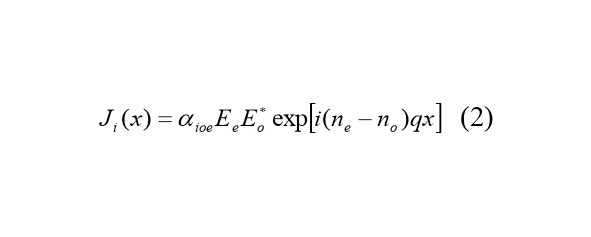
where ne, n0 are the refractive indices of ordinary and extraordinary rays, Ee and E0* are the projections of the polarization vector of light on the optical axes of the crystal,
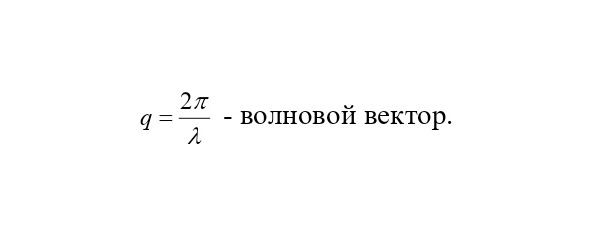
In this case, the photovoltaic current (2) oscillates in the crystal with a period of
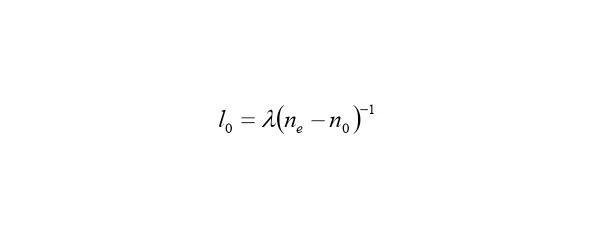
As indicated in [4] and as can be seen from (2), a spatially oscillating photovoltaic current (SWEAT) can be experimentally observed under conditions of strong light absorption.
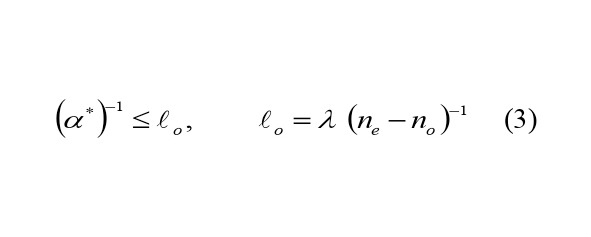
where α* is the absorption coefficient.
1. SPATIALLY OSCILLATING PHOTOVOLTAIC CURRENT IN SbSi FERROELECTRIC
In this paper, a spatially oscillating photovoltaic current (POFT) in the direction [100] in the SbSI ferroelectric is detected and investigated when illuminated with polarized light in the direction [010].
Antimony sulfoiodide (SbSI) belongs to the class of chalcogenides of metals of the fifth group AVBVICII, where A-Sb; Bi; B-S, Se, Te; C-CL, Br, I. SbSI and SbSIxBr1-x crystals are biaxial, have a large double refraction, below temperature. Curie Tc=220C SbSI crystals belong to the mm2 class and have rhombic symmetry. During the phase transformation, the center of symmetry disappears, therefore, SbSI crystals become ferroelectrics below the transition point.
The phase transition at 220C was registered for the first time by Fatuzzo [5] with a change in the temperature dependence of the dielectric constant. Crystals have pronounced semiconductor properties, their photovoltaic properties are well studied [1].
Measurements were carried out for SbSI single crystals in the ferroelectric phase at a temperature of T = 133 K. The crystal was illuminated by plane polarized light using a xenon lamp and a ZMR monochromator. The stationary photovoltaic current J was measured by the method previously described [1]. In accordance with the SbSI symmetry (point group mm2), when measuring Jz (z is the direction of spontaneous polarization) and illuminating the crystal in the x and y directions, POFT does not occur. The expression for the photovoltaic current Jz when illuminated in the x and y directions, respectively, has the form:

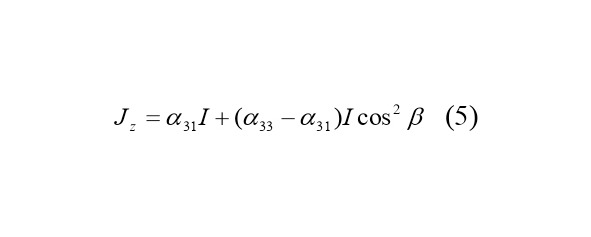
where I is the light intensity, β is the angle between the plane of polarization of light and the z axis. In Fig.1, curve 1 represents the experimental angular dependence of Jz (β) for λ=600 nm when illuminated along [100]. From the comparison of the experimental angular dependences of Jz (β) with (4) and (5), the numerical values of αιjκ or photovoltaic coefficients were estimated

Taking into account pleochroism and anisotropy of light reflection in SbSI [6], the following values were obtained:
K314*10—8; K323*10—8; K33 (2—3) *10—8A*cm* (W) -1. Thus, in SbSI, the photovoltaic coefficients K31, K32, K33 are more than an order of magnitude higher than the corresponding coefficients in LiNbO3: Fe.
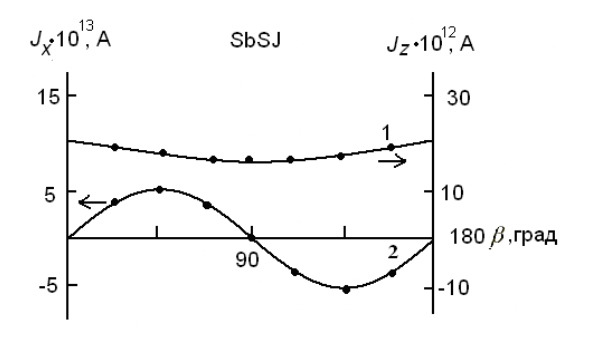
According to (2), for SbSI, the photovoltaic current components are spatially oscillating. However, when the crystal is illuminated in the region of strong absorption in the direction of the x or y axes and when condition (3) is met, currents flow along the surfaces (100) and (010), respectively.
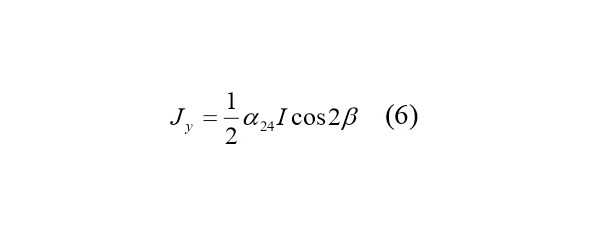
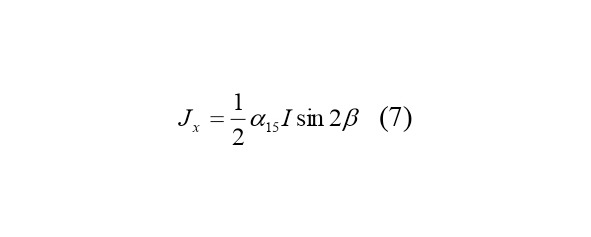
where β is the angle between the plane of polarization of light and the z axis. According to [1,7] for SbSI, the strong absorption condition (3) should be fulfilled already at λ470 nm. To observe the POFT under conditions of strong absorption, silver electrodes in the form of bands parallel to the axis of spontaneous polarization z were sprayed onto the face of the cinacoid (010). Using these electrodes, when the crystal was illuminated in the direction [010] by polarized light with λ=460 nm, the current Jx curve 2 was measured and the current Jz was measured in the long-wavelength region (λ=600nm, curve 1).The angular dependence of the measured current satisfies (5), while the Oh current in this region cannot be observed at all due to violation of condition (3) and spatial oscillation. Figure 2 shows the spectral Jz (curve 1), Jx (curve 2), attributed to the unit of incident energy, as well as the spectral dependence

constructed taking into account the dispersion of n0, pe and the absorption coefficient α* in the [010] direction.
Angular dependence Jx (β) in the form of curve 2, which agrees well with (7) at K15= (2—4) ·10—9A·cm· (W) -1 (λ=460nm).
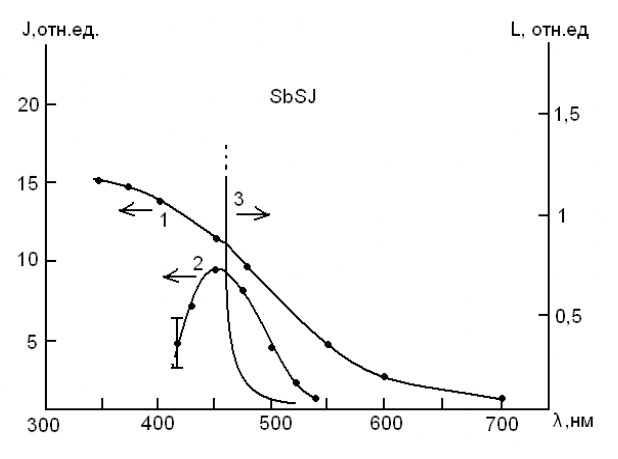
While the spectral dependence measured earlier in is monotonic, the spectral dependence of Jx detects a sharp maximum near L1. Thus, the decline of Jx in the long-wave region, where L <<1, is due to POFT. The decline of Jx in the short wave region, where L> 1, is interesting.Since the AF effect is not related to the lifetime of nonequilibrium carriers, it is possible that this short-wave decline of Jx is due to a decrease in K15 and, consequently, mobility in the direction [100].
2. SPATIALLY OSCILLATING PHOTOVOLTAIC CURRENT IN A FERROELECTRIC α-HgS
The paper considers photovoltaic effects in optically active α-HgS crystals. Some experimental and physical bases of the photovoltaic effect in active crystals are discussed.
Mercury sulphide HgS exists in two modifications: the black modification — metacinnabarite (β-HgS) - crystallizes in a cubic system (point group 3m), the red modification–cinnabarite or cinnabar (α-HQs) — crystallizes in a trigonal system (point group 32).
Red cinnabar crystals with a particularly large specific rotation along the optical axis for the red rays transmitted by them r= 2350/mm were studied in this work. Α — HgS crystals grown by the hydrothermal method in the Laboratory of Hydrothermal Synthesis at the Institute of Crystallography of the Russian Academy of Sciences were studied. The starting materials for the manufacture of cinnabarite were pure mercury in sulfur. Electrical, electro-optical properties of α-HgS crystals and photoelectric properties of crystals were studied in [5,6].
It is shown that the optical activity of the α-HgS crystal has a stronger effect on the angular distribution of the photovoltaic current measured in linearly polarized light.
Fig. 3. shows the orientation dependence of the photovoltaic current Jx (β) in α-HgS. In accordance with (1) and the symmetry of the point group 32, the expression for Jx (β) when illuminated in the direction of the y axis has the form
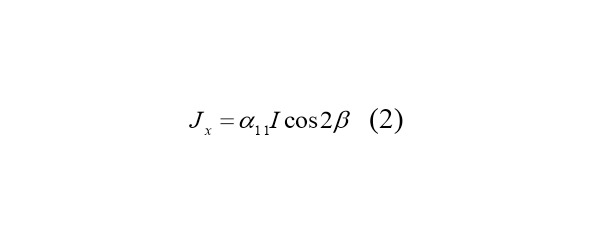
where is the angle between the plane of polarization of light and the x—axis.
Comparison of the experimental angular dependence of Jx (β) with (2) gives
K11= (1—2) *10—9A* cm * (W) -1 (T=133 Κ, λ=500nm). The coincidence of the experimental angular dependence of Jx (β) with (2) shows that in the region of strong absorption (λ=500nm, α*>> 100cm-1), the effect of optical activity in the direction of the y axis on the angular distribution of Jx (β) is insignificant.The effect of optical activity in the z-direction was found when studying the angular dependence of Jx (β) in various spectral regions (Fig.1).The effect of optical activity in the z-direction was found when studying the angular dependence of Jx (β) in various spectral regions (Fig.1).The effect of optical activity in z- The angular dependence of Jx (β) in various spectral regions was discovered during the study of the angular dependence of Jx (β) in various spectral regions (Fig. 1).
In accordance with (1), the angular dependence of Jx (β) illumination in the z — direction (the z axis coincides with the axis of symmetry of the third order) has the form.
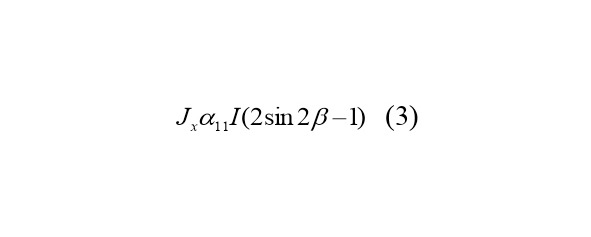
where β is the angle between the plane of light polarization and the y axis.
Figure 2 indicates a good correspondence between the experimental dependence of Jx (β) and (3) in the region of strong light absorption (λ= 400nm).The transition from the short-wave to the long-wave region, corresponding to a decrease in α*, changes the nature of the angular dependence of Jx (β) and its amplitude.The transition from the short-wave to the long-wave region, corresponding to a decrease in α*, changes the nature of the angular dependence of Jx (β) and its amplitude.
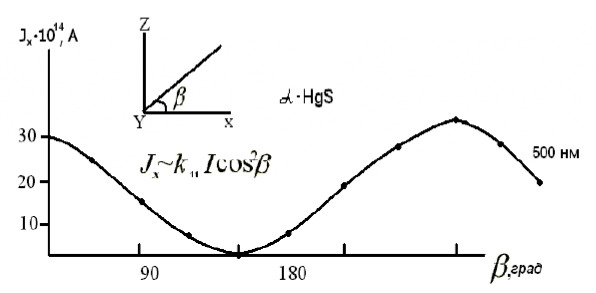
Figure 4 shows the spectral-angular diagram of the photovoltaic current Jx. Obviously, its shape is determined by its optical activity in the z-direction, its spectral dispersion, as well as the spectral distribution of the photovoltaic effect in α-HgS.
The optical dependence in the z — direction thus leads to the formation of the structure of the spatial oscillating photovoltaic current Jx. The photovoltaic current oscillates in the z-direction with a period of

Where χ is the optical activity coefficient.
The angular dependence of Jx (β) coincides with (3) only under the condition of strong light absorption

where α* is the light absorption coefficient.
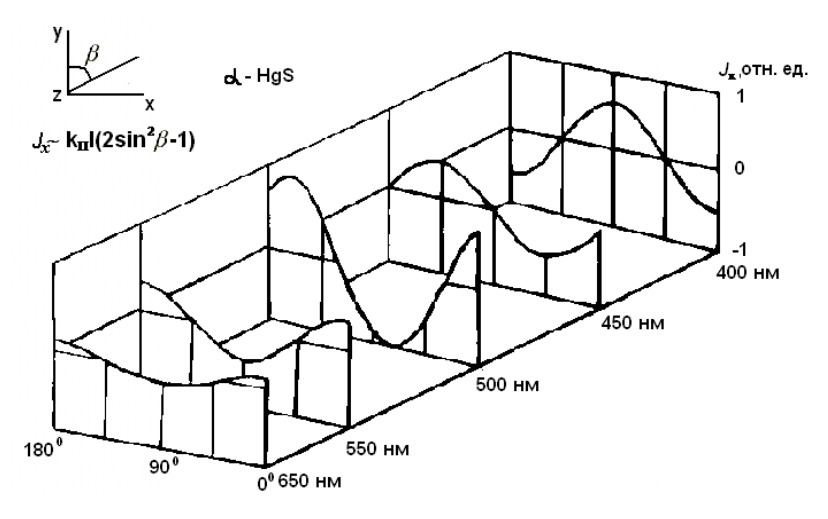
Note: The Board of Authors thanks V. A. Kuznetsov for providing the crystals and V. M. Fridkin for the discussion.
Literature
1. Glass A.M.Van der Liebe D. Herren T.J. High- voltage Bulk Photovoltaic effect and the Photorefractive process in Limbo. //J. Appl. Phys. Lett. 1974. N4 (25) p.233-236.
2.Fridkin V.M., Photosegnetoelectrics. M., Nauka, 1979, pp.186-216.
3.Belinicher V. I. Studies of photovoltaic effects in crystals. Diss. for the job application. Doctor of Physical and Mathematical Sciences. Novosibirsk. 1982. 350 P.
4. Sturman B. I., Fridkin V. M. Photovoltaic effects in media without an inversion center. -M., Nauka.1992. -p-208.
5. Efremova E. P., Kuznetsov V. A., Kotelnikov A. R. Crystallization of cinnabar in hydrosulfide solutions. // J. Crystallography. 1976. vol.21. v.3. pp.583—586.
6. Donetskikh V. I., Sobolev V. V. Reflection spectra of trigonal HgS. // J. Optics and spectroscopy. 1977. vol.42. v.2. pp.401—403.
7.Fridkin V. M. Volumetric photovoltaic effect in crystals without a center of symmetry. // Crystallography. 2001. Vol. 46, N 4. pp. 722—726.
РОЛЬ РЕЗОНАНСНЫХ ЯДЕРНЫХ РЕАКЦИЙ В СОВРЕМЕННОЙ ЭНЕРГЕТИКЕ. THE ROLE OF RESONANT NUCLEAR REACTIONS IN MODERN ENERGY
Жалолов Ботирали Рустамович
Генеральный директор «Clipper Energy» LLC и «Clipper Associates» Corp
«Clipper Energy» LLC, «Clipper Associates» Corp., Malaysia
Каримов Боходир Хошимович
Кандидат физико-математических наук, доцент физико-технического факультета Ферганского государственного университета
Алиев Ибратжон Хатамович
Студент 2-курса факультета математики-информатики Ферганского государственного университета
Ферганский государственный университет, Фергана, Республика Узбекистан
Zhalolov Botirali Rustamovich
General Director of «Clipper Energy» LLC and «Clipper Associates» Corp
«Clipper Energy» LLC, «Clipper Associates» Corp., Malaysia
Karimov Bahodir Khoshimov
Candidate of Physical and Mathematical Sciences, Associate Professor of the Faculty of Physics and Technology of Fergana State University
Aliev Ibratjon Khatamovich
2nd year student of the Faculty of Mathematics and Computer Science of Fergana State University
Ferghana State University, Ferghana, Republic of Uzbekistan
Аннотация. Современную энергетику просто невозможно представить без составляющей в лице атомных электростанций, в основе которых лежат явления распада урана-238 и урана-235, в том числе с использованием саморазмножающихся методов деления. Но как известно источники не вечны, по этой причине важно нахождение нового способа по выделению максимально большого количества электрической энергии и, если верить результатам современных исследований, явным кандидатом на подобный титул могут стать резонансные ядерные реакции, которые изучаются на основе совершенно новой науки — физики резонансных ядерных реакций (ФРЯР).
Ключевые слова: физика резонансных ядерных реакций, энергетическая составляющая, кулоновский барьер, ядерные реакций, физика атомного ядра и элементарных частиц, ядерное эффективное сечение, длина волны.
Annotation. It is simply impossible to imagine modern energy without a component in the face of nuclear power plants, which are based on the decay phenomena of uranium-238 and uranium-235, including using self-multiplying fission methods. But as you know, the sources are not eternal, for this reason it is important to find a new way to release as much electrical energy as possible and, if you believe the results of modern research, resonant nuclear reactions, which are studied on the basis of a completely new science — physics of resonant nuclear reactions (PRNR), can become a clear candidate for such a title.
Keywords: physics of resonant nuclear reactions, energy component, Coulomb barrier, nuclear reactions, physics of atomic nucleus and elementary particles, nuclear effective cross section, wavelength.
А. Русская версия
1. Общие понятия ядерных реакций
Сама по себе ядерная реакция, это процесс взаимодействия атомного ядра с другим ядром или элементарной частицей, которая может сопровождаться изменением структуры, строения, состава ядра, образованием новых ядер или элементарных частиц и введением дальнейших изменений. Также последствием ядерной реакции может стать его деление, спускание как элементарных частиц, так и безмассовых протонов. Вместе с этим, из-за действия несколько иных законов, при которых масса активно может превращаться в энергию и обратно, кинетическая энергия результирующих частиц вполне, может быть, не равна сумме изначальных.
Подобные ядерные реакции являются экзо-энергетическими или выделяющими энергию. Первая ядерная реакция была проведена Эрнестом Резерфордом в 1917 году, при бомбардировке альфа-частицами ядра атомов азота. Она была полностью зафиксирована благодаря появлению вторичных ионизирующих частиц, пробег коих в газе был больший чем пробег альфа-частиц, после чего и были идентифицированы как протоны. Процесс же позже был сфотографирован.
К слову, об этом, важно сказать, что для фотографирования ядерных реакций используется камера Вильсона. Говоря же о механизмах взаимодействия, то можно выделить два вида такого взаимодействия, а именно:
1. Реакция с образованием составного ядра, этот процесс состоит из двух стадий, при этом налетающая частица соединяется с самим бомбардируемым ядром, составляя общее ядро, которое позже распадается. Такая ядерная реакция протекает на небольших энергиях, до 10 МэВ;
2. Прямые ядерные реакции, проходящие уже сразу, за ядерное время, которое составляет мельчайшие доли секунды и рассчитываются исходя из иных факторов, одним из которых является время пересечения ядра частицей. Главным образом такой вид реакции выражается лишь на очень больших энергиях бомбардирующих частиц.
В случае сохранения первоначальных ядер после самой ядерной реакции, также не рождаются новые частицы, то реакция считается упругим рассеянием в поле ядерных сил, без какого-либо внутреннего взаимодействия. Такая реакция сопровождается лишь передачей кинетической энергии и импульса одной налетающей частицы ядру-мишени, называясь потенциальным рассеянием и полноценно подчиняясь законам сохранения импульса в этом случае.
Ранее были упомянуты механизмы реакции, но стоит несколько подробнее на них остановиться. Первая реакция, а именно механизм составного ядра был впервые разработан и предложен Нильсом Бором в 1936 году совместно с знаменитой теорией капельной модели. Данная теория даже сегодня лежит в основе больших представлений о всех ядерных реакциях.
Если следовать данной теории, то как и было описано, ядерная реакция следует в два этапа, при этом весь процесс от столкновения, образования составного ядра и его распада занимает в рамках 10-23-10-21 с. И важно отметить, что какое бы не было составное ядро, оно всегда является возбуждённым из-за избыточной энергии, которая вносится частицей в лице энергии связи нуклонов в составном ядре и части кинетической энергии составного ядра, которая равна сумме кинетической энергии ядра-мишени с определённым большим массовым числом и налетающей частицы в системе так называемого центра инерции.
Здесь важно определить такое понятие как энергия возбуждения составного ядра, которое образовалось при поглощении свободного нуклона. Она составляет сумме энергии связи нуклонов ядра-мишени и части его кинетической энергии (1).
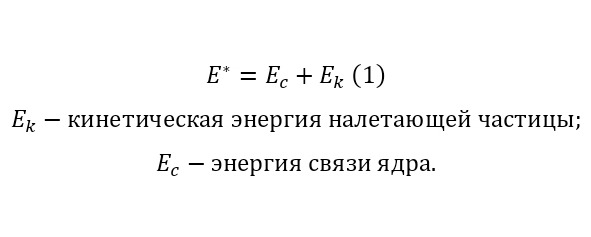
Часть кинетической энергии из-за большой разницы в массах ядра и нуклона в таких случаях становится равной кинетической энергии бомбардирующего нуклона. В среднем же энергия связи равна 8 МэВ и может изменяться только при отличительных особенностях образуемого в этом процессе составного ядра, но для точно указанного ядра-мишени и нуклона, это значение — константа. Кинетическая же энергия частицы может быть какой угодно, к примеру, в ядерных реакциях, где налетает нейтрон, за счёт того, что отсутствует отталкивающая сила ядра — кулоновский барьер, их энергия может быть крайне близка к нулю.
Таким образом, кинетическая энергия является минимальной энергией возбуждения составного ядра.
И именно из утверждения наличия составного ядра и существованию каналов распада ядер, можно сделать вывод о существовании каналов реакций. Сами по себе каналы реакции — это способы перехода из возбуждённого в невозбуждённое состояние. Типа и квантовое состояние налетающих частиц и ядер до начала реакции определяют входной канал ядерной реакции, после завершения же реакции совокупность образовавшихся частиц, то есть продуктов реакции и их квантовое состояние определяется результирующий выходной канал реакции. Полная характеристика ядерной реакции осуществляется входными и выходными каналами.
Составное ядро само по себе живёт довольно долгое время, благодаря чему сам выбор канала реакции вовсе не зависит от способа образования составного ядра, благодаря чему оно «забывает», как было образовано. Это становится причиной для утверждения независимости процессов организации составного ядра и его распада. Ярким примером может быть ситуация образования возбуждённого ядра алюминия-27 следующими способами (2).
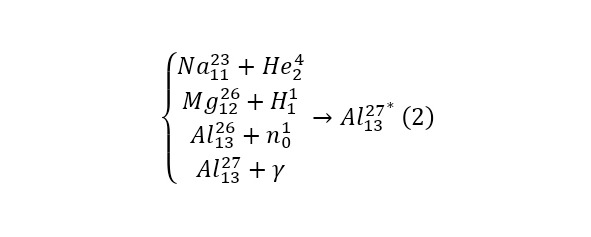
Но распадается это яро одинаково во всех случаях, при условии одинаковой энергии возбуждения. Но при этом имеется и возможно распада обратным любой из этих реакций, с определённой вероятностью, не зависящей от истории возникновения самого возбуждённого ядра. Если же говорить о вероятности таких событий, то зависимость становится между сортом ядра-мишени и энергий.
Как и было ранее указано, ядерные реакции могут также протекать и по прямому каналу взаимодействия при больших энергиях, поскольку нуклоны ядра можно рассматривать как свободные. Отличие от предыдущей модели составного ядра от модели прямых реакции состоит изначально в распределении векторов импульсов частиц-продуктов ядерной реакции, относительно импульса бомбардирующих частиц. Если же в составной модели действует сферическая симметрия, то в данном случае геометрия более проста и преимущество в выборе направлений результирующими частицами состоит в направлении входящих частиц.
Ранее упоминалось понятие вероятности ядерной реакции, которая представляется величиной, которая называется эффективным сечением ядерной реакции. В лабораторной системе отчёта принимается ситуация покоя ядра-мишени, вероятность взаимодействия определяется произведением сечения на поток падающих частиц, при этом сечение выражается в единицах площади, а поток в количестве частиц, пересекающих единицу площади в единицу времени. Само сечение ядерной реакции исчисляется в крайне малых единицах площади — барнах, равных 10—24 см2.
Отношение случаев реакции, отнесённое к числу бомбардировавших мишень частиц, называется выходом ядерной реакции. Эта величина определяется экспериментально при количественных измерений, что связано с сечением реакций, а измерение этого выхода в самой сути — измерения сечения реакции.
Законы физики, в том числе и законы сохранения конечно же действуют и в ядерных реакциях. Эти законы накладывают определённых ограничения на возможность самого осуществления ядерной реакции. Также существуют и некоторые более специфичные законы сохранения, свойственные для микромира, примером таких могут стать закон сохранения барионного или лептонного числа. Они выполняются на всех известных реакциях, но некоторые другие законы сохранения чётности, изоспина, странности, лишь действуют в фундаментальных взаимодействиях. Следствие из них — это правила отбора, определяющие настоящие и невозможные ядерные реакции, которые можно осуществить.
Закон сохранения энергии в ядерных реакциях действуют предсказуемо, но очень специфически для представителей макромира. При этом выполняется равенство сумм полных энергий (3).
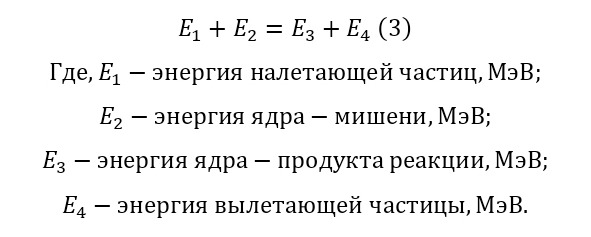
Если же расписать (3), то можно получить (4), из которого следует энергия реакции (5), которая удовлетворяет (6).
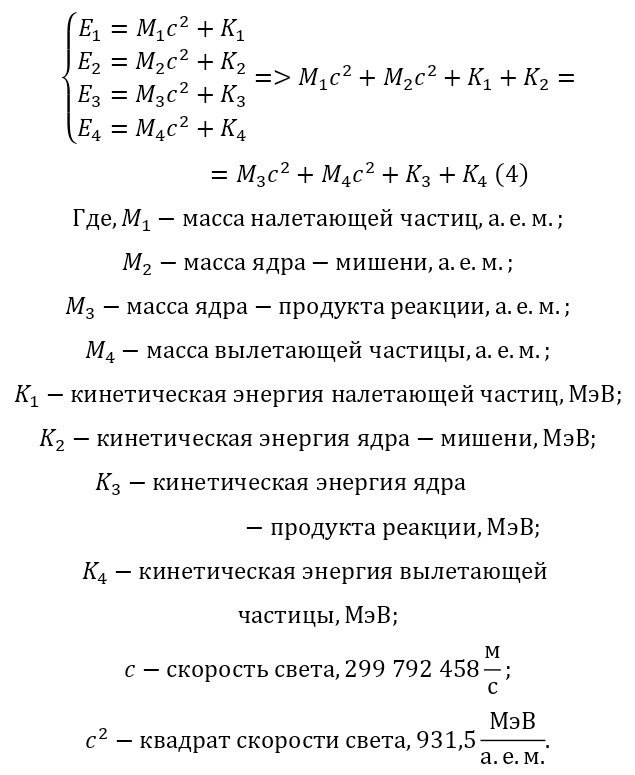
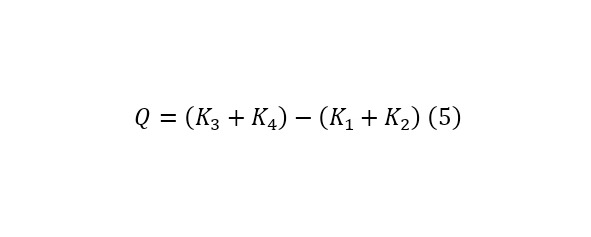
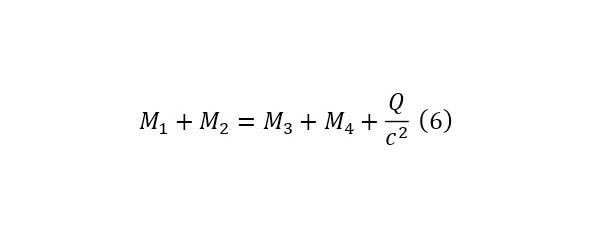
Таким образом (5), можно переписать и как (7).
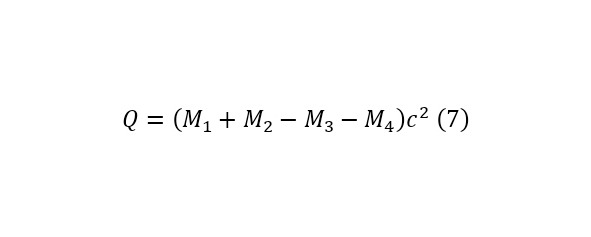
Если же выход реакции больше нуля, то это реакция экзо-энергетическая и сопровождается выделением энергии в кинетическую энергию продуктов реакции, в обратном случае — поглощением и называется эндо-энергетической. Регулировка подобного процесс становится понятным и по разности масс до и после реакции и при положительной разности можно сказать, что она превращается в кинетическую энергию и реакция генерирует энергию, в обратном случае, то есть при отрицательной разности, процесс её поглощает.
Также действует и закон сохранения импульса, что очень хорошо заметно при прямых реакциях (8).
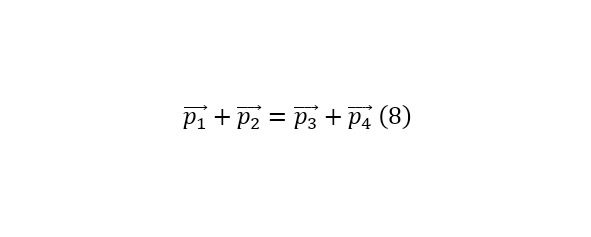
Вместе с этим существует и закон сохранения момента импульса и целых ряд иных законов, но самыми основными действующими в реакции, являются эти два закона сохранения.
Но теперь важно остановиться на видах ядерных реакций, а существует их несколько: ядерная реакция деления, синтеза, термоядерная реакция и фотоядерная реакция. Первый вид — ядерная реакция деления, это процесс расщепления атомного ядра на два, а реже на три ядра с близкими ядерными массами, которые называются осколками деления. Также могут возникать и иные продукты реакций, в том числе лёгкие ядра — альфа-частицы, дейтроны, а также нейтроны и гамма-кванты. Деление само по себе спонтанно и самопроизвольно, либо же вынужденное, из-за взаимодействия с другими частицами, к примеру нейтронами. Деление тяжёлых ядер — это в большинстве случаев экзо-энергетический процесс, что позволяет из этого процесса получать энергию из излучения и кинетической энергии продуктов.
Ядерная реакция синтеза — второй ядерный процесс, которые состоит в слиянии двух ядер с образованием нового, более тяжёлого ядра. Такой процесс часто сопутствуется излучением гамма-квантов или других элементарных частиц. Слияние ядер чаще всего эндо-энергетический процесс, из-за чего чаще всего требуется введение энергии через кинетические энергии частиц, чтобы преодолеть кулоновский барьер — электростатическое отталкивание ядер. Слияние двух ядер и придание им энергии может осуществиться, как не сложно догадаться в ускорителях заряженных частиц, либо же эти частицы изначально обладали этой энергией, к примеру частицы космического излучения, но есть ещё один способ — это нагрев вещества до крайне высоких температур в специальном термоядерном реакторе, где кинетическая энергия частиц и температуры крайне огромны.
Таким образом можно подойти и к термоядерным реакциям. В таких реакциях, слияние лёгких ядер приводит к превращению излишней массы первоначальных ядер в энергию, поскольку суммарная масса слившихся ядер больше массы результирующего ядра-продукта реакции.
Из этого можно сделать вывод, что ядерной реакции синтеза исходные ядра должны обладать относительно большой кинетической энергией, ибо они испытывают довольно мощное электростатическое отталкивание при прохождении с их стороны кулоновского барьера. Их кинетическую энергию, по молекулярно-кинетической теории можно представлять в виде температуры всего вещества, следовательно нагрев приведёт к увеличению кинетической энергии составных частиц и их слиянию. Именно так и развивается нуклонный синтез в недрах звёзд с образованием новых ядер под огромной температурой.
В частности, в большом количестве происходит реакция слияния протонов, ядер гелия, а также как побочный результат, образуются и иные изотопы веществ, в том числе дейтерий и тритий, как изотопы водорода. И наконец, последний вид ядерной реакции — фотоядерная реакция, в этом случае происходит поглощение гамма-кванта с достаточной энергией, чтобы возбудить нуклонный состав, то есть ядро, благодаря чему оно становится составным, то есть его можно считать таковым, а также высвобождает из себя иную структуру, либо распадается.
Данный процесс и называется фотоядерной реакцией или ядерным фотоэффектом. И в заключение стоит отметить, что ядерные реакции могут быть записаны как в виде уравнения, как это демонстрировалось ранее, или, к примеру в (9), также имеет место несколько иная запись (10).
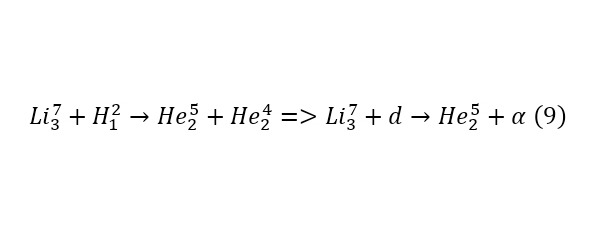

По итогу можно сделать о большой важности наличия знаний о самих ядерных реакциях у любого исследователя, контактирующего с данной областью, в том числе и с физикой резонансных ядерных реакций.
И если заметить, то как и было отмечено, ядерная физика развивалась на протяжении многого времени, не говоря о времени, которое потратило человечество, для изучения структуры всей материи и вещества в целом. Но активные исследования привели к совершенно недавнему открытию нового направления в этой области, а именно к физике резонансных ядерных реакций. Впервые подобная терминология была использована и практически продемонстрирована в монографии 2021 года Алиева И. Х. и Шарофутдинова Ф. М. «Использование ускорителей и явлений столкновения элементарных частиц с энергией высокого порядка для генерации электрической энергии. Проект „Электрон“», которая в дальнейшем получила своё продолжение.
2. Физика резонансных ядерных реакций
Создателем физики резонансных ядерных реакций, является Алиев И. Х., но на чём же основана эта дисциплина? Она изучает и определяет максимально благоприятные условия для возникновения своего рода скачков мощностей продуктов ядерных реакций, которые и носят название резонансов. Если говорить проще, то, когда проходит ядерная реакция, у неё образуются продукты реакции, о которых говорилось в одной из предыдущих лекций и все обстоятельства, которые приводят к тому, что реакция будет более эффективной и их энергии будут большими и является тем, что изучает физика резонансных ядерных реакций.
Рассмотрим на примере. Пусть на ядро некоторого элемента направляются заряженные частицы, это могут протоны, ионы, электроны, всё что угодно. И при приближении к ядру, возникает явление кулоновского отталкивания, он действует только на одноимённые заряды, а именно на ядра, но не действует на нейтральные частицы, к примеру на нейтроны, хотя сами нейтроны тоже имеют минимальный заряд. Частица тратит какую-то энергию на преодоление кулоновского барьера и остаётся с некоторой её частью, которую она тратит на преодоление самого ядра и дальнейшего прохождения ядерной реакции.
В реакции выделяется соответствующая энергия, если это эндо-энергетическая, за счёт неравности масс, то есть какая-то часть массы превращается в энергию и её уже получают продукты самой реакции — вылетающие частицы, а также они получают ту оставшуюся часть энергии от бомбардировавшей частицы. И общая энергия этих продуктов реакции определяется по соответствующему математическому аппарату, но нам необходим скачок именно мощности.
Мощность — это произведение тока пучка на его энергию, то есть напряжение. Энергия действительно для благоприятных реакций большая и измеряется в МэВ, но ток крайне мал. Нужно каким-то образом его увеличить. Чтобы это сделать, необходимо понять явление вероятности прохождения ядерной реакции. Пучок сам по себе он и волна, и корпускула, то есть частица, согласно корпускулярно-волновому дуализму, о котором можно подробнее узнать из курса квантовой физики, поэтому она имеет свою длину волны де Бройля (1).
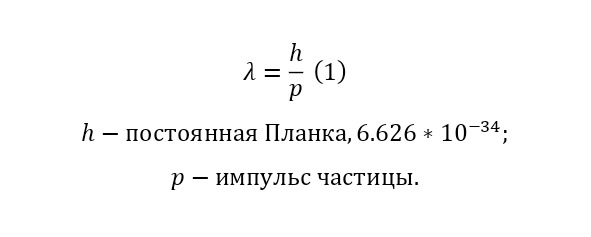
И когда частица приближается к ядру, даже если она в неё не попала и не дотронулась до него, если она находится на расстоянии своей длины волны, то взаимодействие будет. Да, действительно, даже не касаясь частица может «удариться» и войти во взаимодействие, таковы законы микромира. Значит, нужно увеличить эту длину волны, а для этого нужно уменьшить импульс, но, чтобы уменьшить импульс, нужно уменьшить скорость.
Но уменьшать скорость нужно так, чтобы частица прошла кулоновский барьер, из этого и можно сделать вывод, что энергия частицы максимально должна быть близкой к кулоновскому барьеру. И здесь, величина кулоновского барьера — это и есть резонансная энергия этой ядерной реакции.
Теперь, как же определить выходящую мощность? Для этого нужно вычислить энергию, что уже просто сделать, но как же определить резонансных ток? Чтобы его определить представим следующее. Пластина-мишень состоит из расположенных атомов и пусть внутрь входит определённое число заряженных частиц. Если расположить на начале мишени систему отсчёта, то можно использовать следующее положение о том, что частицы пройдут некоторую часть мишени, которая начинается на определённой координате и завершается на координате суммы этой координаты и толщины самой части, а толщина равна разности этих координат.
Встаёт вопрос к этому условию: сколько входящих заряженных частиц войдут во взаимодействие? Для этого укажем, что на первой координате имеется N (x) частиц, а на конечной точке N (x) -dN, соответственно, где dN — число взаимодействовавших заряженных частиц.
Определим количество ядер в этом отрезке двух координат — x и x+dx, если толщина между ними dx. Для этого введём значение плотности ядер, которое определяет количество ядер вещества в единице объёма, она определяется как отношение плотности вещества на его атомную массу в кг и изменяется в ядро/м3 (2).
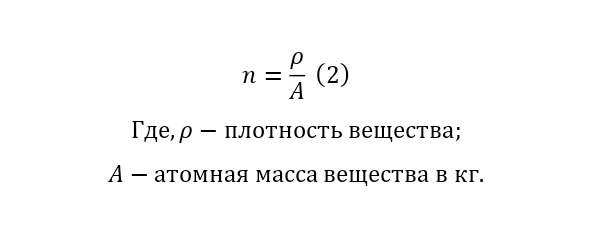
Чтобы определить сколько ядер в указанной точке, достаточно эту величину (2) умножить на объём в этой части пластины, для этого её площадь умножается на толщину и на (2), что указано в (3).
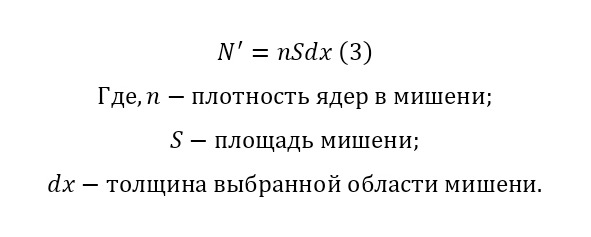
Но чему равна площадь, попав в которую ядро попадёт во взаимодействие? Для одного ядра введём понятие ядерного эффективного сечения, той самой области, а поскольку действия происходят в круге относительно ядра атома, то эта величина определяется по (4).
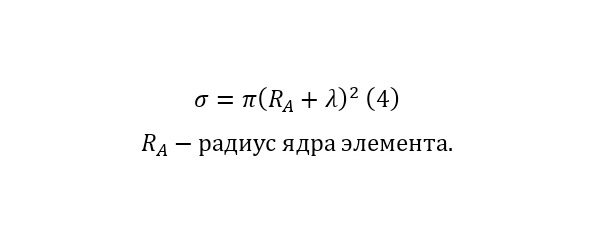
Таким образом, площадь доступная для взаимодействия составляет (5).
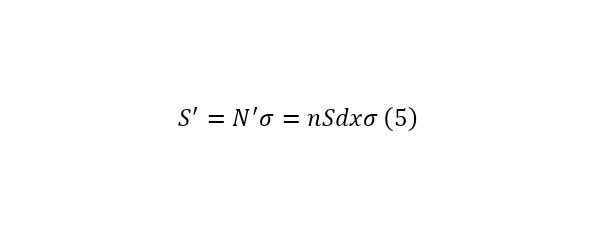
Но отношение этой площади ко всей площади плиты ведь равняется отношению количества всех оставшихся без взаимодействия частиц на общее количество частиц, то есть верно (6).
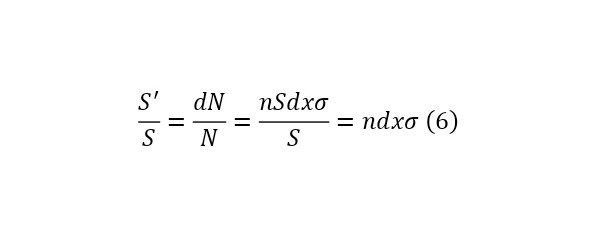
Теперь, введём численное определение для (6), а для этого проинтегрируем обе части (7) отдельно в (8) и (9), а затем получим общий результат (10).
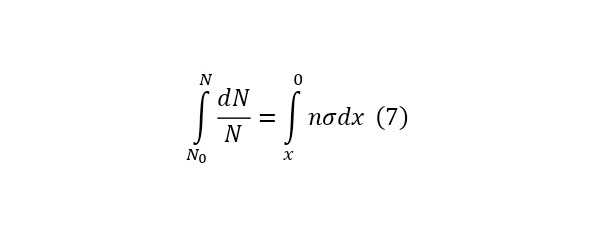
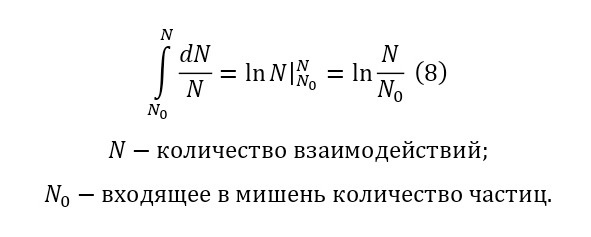
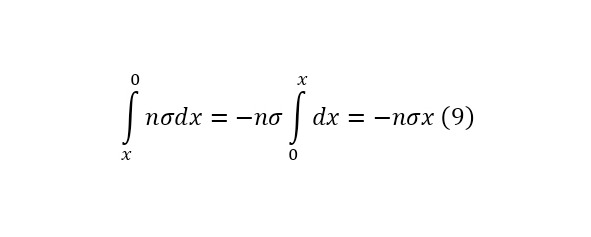

Отсюда можно получить значение про-взаимодействовавших частиц (11).

А выходящую мощность можно вычислить и благодаря (12).

Откуда и получается скачок в мощности, то есть резонанс при приближении к энергии кулоновского взаимодействия в ядерной реакции. Именно этот процесс и является основной в этом направлении, которая позволяет при калибровке энергии получать резкие скачки в мощностях, а чтобы их осуществить необходимо создание и разработка специальных моноэнергетических ускорителей заряженных частиц с первым линейным ускорением, далее циклотронным.
Сегодня ведётся разработка единственного во всём мире моноэнергетического ускорителя ООО «Electron Laboratory» совместно с Объединённым Институтом Ядерных Исследований и Федеральным Государственным Унитарным Предприятием «Научно-исследовательский Институт Электрофизической Аппаратуры имени Дмитрия Васильевича Ефремова» и других организаций.
Для описания самого ускорителя достаточно привести небольшое цитирование из монографии Алиева И. Х. «Новые параметры по ядерным реакциям для осуществления на ускорителе заряженных частиц ЛЦУ-ЭПД-300»:
«Когда же актуальность проблемы энергетического голода в планетарном масштабе не раз была доказана и продемонстрирована проблема необходимости создания устройства и метода генерации электрической энергии с высокой эффективностью в крайне больших масштабах, что позволяло бы разрешить эту проблему и открыть путь для целого спектра многочисленных проектов и научных работ, нуждающиеся в подобном источнике электрической энергии, становится следующим этапом на пути развития этого большого проекта.
И поскольку проводились необходимые исследования в области поиска подобного источника и метода генерации энергии, то наконец решением были признаны ядерные реакции, которые бы увеличивали собственное сечение, следовательно, как вероятность прохождения самой реакции, так и количество действовавших реакций, что конечно же напрямую связано с общей эффективностью всей ядерной реакции. Что вытекает при учёте, что энергия вылетающих частиц из ядерной реакции, во всём картеже частиц, это общее напряжение, а количество вылетающих частиц, благодаря их заряду создаёт параметр силы тока системы.
Благодаря тому, что энергии подбираются с таким расчётом, что после прохождения кулоновского барьера, частица обладает энергией равной энергии её теплового аналога и уже этот факт увеличивает эффективное сечение всей ядерной реакции, в которое вступает частица, то такие ядерные реакции можно назвать резонансными, благодаря тому, что они вызывают резонанс в системе и только этим увеличивают общую эффективность всего осуществляемого процесса.
Резонансные ядерные реакции, впервые были открыты в сентябре 2021 года, после чего проводились активные исследования, которые привели к ряду публикаций, самым значительным среди которых было произведено в декабре 2021 года, коим является монография Алиева И. Х. и Шарофутдинова Ф. М. «Использование ускорителей и явлений столкновения элементарных частиц с энергией высокого порядка для генерации электрической энергии. Проект „Электрон“», к которой привело исследование в области поиска данного метода на протяжении 12 лет, при том учёте, что поиск в области физики атомного ядра и элементарных частиц, а также квантовой физике проходило на протяжении значительных 5 лет. Наименование резонансных ядерных реакций было придано данным системам в январе 2022 года со стороны Каримова Боходира Хошимовича и впервые фигурирует в данном исследований.
Благодаря тому, что актуальность резонансных ядерных реакций быстро вытекает из вышесказанного, то остаётся доказать актуальность того факта, что для осуществления указываемых ядерных реакций необходим ускоритель заряженных частиц, специального типа ЛЦУ (Линейно-циклотронный ускоритель), его класс ЭПД-20, вытекает из параметров, что в нём пучками являются протонные и дейтериевые пучки проекта «Электрон» с энергией до 20 МэВ. Благодаря тому, что энергия должна быть подобрана, к примеру, для обычной ядерной реакции бомбардировки лития-6 с выделением двух альфа-частиц необходимо наличие у протона с энергией 1,613245483 МэВ, и только при этом случае будет допускаться, что конечная энергия протона, после прохождения кулоновского барьера на ядерном радиусе составит 0,25 эВ, благодаря чему протон становится, что называется «тепловым» и эффективное сечение этой ядерной реакции измеряется уже в огромные единицах — кБн.
Но на сегодняшний день на всей планете нет ускорителя класса ЛЦУ, не говоря уже о подробном типа, имея общую кодировку ЛЦУ-ЭПД-20, который смог бы придать энергию протону равную 2,312691131 МэВ для первой, 1,978142789 МэВ для второй, 1,613245483 МэВ для третьей и 4,457595117 МэВ для четвёртой реакции, не потому, что эта энергия не достижима, отнюдь, эта энергия является мизерной в физике ускорителей, поскольку современные ускорители частиц фигурируют с энергиями в ГэВ и ТэВ. Причиной трудно достижимости таких результатов является именно точность, ускорители могут придать энергию в 1 МэВ, 1,5 МэВ или 2 МэВ, то есть конкретные значения, точность которых не превышает 1 или 2 порядков (под порядком имеется ввиду порядок дроби или точнее отрицательная степень основания показательной функции, то есть 10, представленной в модуле), а как видно, для данного эксперимента нужна куда более большая точность.
Важность исследований резонансных ядерных реакций была не раз констатирована в ряде научных статей и проводимых исследованиях, а также для этого была посвящена специальная монография «Использование ускорителей и явлений столкновения элементарных частиц с энергией высокого порядка для генерации электрической энергии. Проект „Электрон“», в которой подробно описывались 6 ядерных реакций, в 4 из которых происходил процесс бомбардировки мишени из бериллия, бора, алюминия и лития протонами, а в 2 из них, происходила бомбардировка мишени из лития-6 и лития-7 дейтронами, за счёт чего выделались на ряду с основным продуктом реакции — альфа-частицами, ещё и целый комплекс иных частиц, которые после отклонений в МГД-генераторе представлялись как электрический ток.
Говоря об описанном научном труде, важно отметить, что это была в первую очередь теоретическая работа, в которой имели места расчёты крайне высоких значений в связи с током, когда заряды пучков крайне большие, как и токи, доходя до нескольких кА. И лишь в завершении учитывались более приближённые данные. В данном же случае ведётся расчёт также и в моменте, когда токи малы и более приближены к реальным. Для сравнения, токи в недавно созданном циклотроне ДЦ-280 не доходили до значения в 1 А, а измерялись лишь в мА.
Такие же параметры можно привести и для электростатического ускорителя «ЭГ-2 СОКОЛ», ныне принадлежащий Научно-исследовательскому Институту полупроводников и микроэлектроники при Национальном Университете Республики Узбекистан.
Следовательно, для осуществления подобного рода ядерных реакций, когда необходимые особые условия, их необходимо в очередной раз указать и уточнить, максимально приблизив к реальным значениям. Кроме того, если подробно остановится на механизме реакций, получается картина с того, что как указывалось, важно наличие специального устройства — ускорителя заряженных частиц, который мог бы придавать большую энергию в размере нескольких МэВ, для заряженной частицы. После чего данная частица наталкивалась бы на мишень определённого вещества, благодаря чему и проходила определённая ядерная реакция. При этом происходит целый ряд процессов, одним из которых является преодоление кулоновского барьера, то есть даже если ядерная реакция происходит с выходом энергии, частица для осуществления этого действия всё равно должна затратить некоторую энергию, но если подобрать общую комбинацию следующим образом, чтобы затрачивалось такое количество энергии, благодаря чему в конечном итоге оставалось малое количество энергии, превращая налетающую частицу в медленную, то вероятность прохода этой реакции резко увеличивается до не малых значений, уже после кулоновского барьера, когда кулоновские силы уже не учитываются и процесс проходит на ядерном радиусе, как и было указано.
Таким образом актуально создание ЛЦУ, который придавал бы энергии заряженным частицам с 9—10 порядком, что значительно увеличивает эффективность всей исследуемой системы и приводит к более точному определению кулоновского и иных барьеров любой реакции. При этом данный ЛЦУ, имеет целый ряд преимуществ наряду со всеми имеющимися ускорителями, поскольку для начала, является комбинацией двух классов ускорителей: циклических и линейных.
Говоря же об ускорителях, важно отметить, что ускорители сами по себе просты, в них частицы ускоряются под действием электрического поля, на этом основан весь принцип. Также нельзя и усомниться в том, что наконец пришло время для реакции первых резонансных ядерных реакций на первом ЛЦУ. Ведь если прибегать к истории, то, к примеру, самый первый ускоритель был построен в 1930 году Лоуренсом Беркли. Первыми ускорителями считаются ускорители 1931 годов, когда был создан 23 см кольцевой циклотрон в Калифорнийском университете на ускорение водородных ионов с энергией в 1 МэВ. Также был разработан в 1932 году 28 см кольцевой протонный циклотрон на энергию в 1,2 МэВ в Беркли. Там же в Калифорнийском университете, Беркли разработаны действующий с 1932 по 1936 гг. 68 см кольцевой дейтериевый циклотрон на энергию 4,8 МэВ; действующий с 1937 по 1938 гг. 94 см кольцевой дейтериевый циклотрон на 8 МэВ; с 1939 г. по нынешнее время действующий 152 см кольцевой тритиевый циклотрон на 16 МэВ; с 1942 г. по нынешнее время действующий 467 см кольцевой циклотрон для различных заряженных частиц на энергию более 100 МэВ. Вместе с этим в 1932 году в Кавендишской лаборатории был сконструирован протонный электростатический протонный ускоритель на энергию 0,7 МэВ Кокрофта-Уолтона, действующий благодаря умножителю напряжения Эрнеста Томаса Синтона Уолтона и сэра Джона Дугласа Кокрофта (лауреатов 1951 г.), уже более известный также как умножитель напряжения Кокрофта-Уолтона.
Также известны ускорители Гарварда (1949—2002), Национальной лаборатории Оук-Ридж (1943-н.в.) для протонов и ядер урана с энергиями от 160 МэВ. Также создавались синхротроны известные как космотрон в Брукхейвенской национальной лаборатории, 1953—1968 гг. 72 метра для протонов в 3,3 ГэВ, также Бирменгемский сихротрон, беватро, ускоритель «Сатурн», Российский синхрофазотрон в Дубне, Протонный циклотрон в ЦЕРН. Перечисление ускорителей может быть довольно долгим процессом, не говоря уже об описании каждого, благодаря разности их видов, характеристик и физики. Поэтому нет места для сомнений в прохождении достаточно пути в данной сфере со стороны мировой науки, чтобы начались исследования и работы в конструировании новейшего циклотрона резонансного типа.
Целью данной научно-исследовательской работы является полная разработка ускорителя заряженный частиц «ЛЦУ-ЭПД-20» (линейно-циклотронный ускоритель протон-дейтериевого циклотрона для проекта «Электрон» с энергией до 20 МэВ, с высоким порядком), для подробного исследования резонансных ядерных реакций.
Задачами данного исследования являются:
· Изучение общей системы работы, физики и истории ускорителей;
· Разработка электрической системы ускорения (ВЧ-система);
· Вычисление параметров и алгоритма создания магнитной системы;
· Изучение вакуумной системы и разработка метода достижения необходимого уровня вакуума;
· Разработка системы контроля действия ускорителя и придачи необходимого уровня энергии;
· Разработка механизма и физики детектирования получаемых результатов;
· Создание технологии математического моделирования системы ускорителя заряженных частиц;
· Описание вариаций работы на ускорителе на примерах резонансных ядерных реакций.
Объектом данного исследования является ускоритель заряженных частиц ЛЦУ-ЭПД-20 резонансного типа.
Предметом исследования является изучение процесса создания ускорителя заряженных частиц резонансного типа, и технология проведения на данном ускорителе экспериментов.
Для данного исследования были применён инструментальный, эмпирический и теоретический метод исследования (с некоторыми оговорками), что выдало необходимые важные результаты.
Научная новизна данной исследовательской работы заключается в следующем:
· Первое слияние двух классов ускорителей: циклотронного и линейного, в итоге чего образуется система ЛЦУ;
· Впервые разрабатывается система, действующая в масштабе 9—10 порядков;
· Открыта возможность к проведению экспериментов с значениями энергий в 3 единиц 11—12 порядок, благодаря варьированию значения до 20 МэВ;
· Первое применение возможности проведения ядерных реакций на протонах и дейтронах с оперированием кулоновскими барьерами на любых ядрах;
· Единственное устройство на планете за всю историю человечество с такой критической точностью эксперимента;
· Указание в качестве первого исследования в области физики резонансных ядерных реакций;
· Первое представление ускорителя заряженных частиц в качестве источника электрической энергии;
· Единственные исследования в качестве ускорителя без перехода к методу генерации электрической энергии с переходом в котлованный механизм;
· Огромный объём генерируемой электрической энергии;
· Возможность перехода на высшие ядра (с 119 ядра).
Говоря о новизне данного исследования, наряду с множеством пунктом, которые в данном случае приводятся лишь частично, важно уточнить тот факт, что особенностью ускорителя, создаваемого для научно-исследовательской лаборатории при проекте «Электрон» ЛЦУ-ЭПД-20 является точность. Именно возможность придавать дуантам определённое напряжение, что при проходе через щели электрического поля, где и осуществляется ускорение пучка, ускоряется только на некоторое число, которая является лишь частью конечной энергии.
Как можно указать в самом названии реакции, необходимо вызвать резонанс, но не из-за частного «совпадения», а именно из-за энергетического подхода, как это описывалось ранее, но будет ещё более подробно описываться в последующих главах, где изначально приводится история ускорительной техники, затем разрабатывается основной физический и математический аппарат, позволяющий уже оперировать с образующимися системами ускорения пучка.
Практические результаты заключатся в следующем:
· Разработана целая программа по реализации ЛЦУ-ЭПД-20;
· Вычислены все необходимые данные ЛЦУ-ЭПД-20;
· Получена вся физика и методы работы для нового ЛЦУ-ЭПД-20;
· Разработана технология создания ускорителя ЛЦУ-ЭПД-20;
· Выражены отличительные черты резонансных ускорителей;
· Разработан проект научно-исследовательской лаборатории при новом проекте «Электрон» с использованием ЛЦУ-ЭПД-20;
· Разработана концепция научно-исследовательской лаборатории при проекте «Электрон» с использованием ЛЦУ-ЭПД-20;
· Опубликована монография «Использование ускорителей и явлений столкновения элементарных частиц с энергией высокого порядка для генерации электрической энергии. Проект „Электрон“» с описанием 1 этапа исследования проекта «Электрон»;
· Планируется публикация целого списка монографий для подробного описания проекта ускорителя ЛЦУ-ЭПД-20;
· Разработана «Дорожная карта» проекта «Электрон».
Достоверность результатов основана на том, что будут использованы общепринятые математические, физические и иные операции. А также будут использованы экспериментальные данные, полученные в различных лабораториях и научно-исследовательских центрах, а также из практики учёных, по созданию такого рода ускорителей.
Данное исследование было не раз обсуждено на собрании докторов и кандидатов физико-математических наук Ферганского Государственного Университета, рецензентов монографии по 1 этапу проекта «Электрон», учёных Ферганского Политехнического Института, а также при контакте-обсуждении с доктором технических наук, доцентом научно-исследовательского института физики полупроводников и микроэлектроники Национального Университета Узбекистана.
Результаты проводимого исследования опубликованы в научных статьях в международных журналах «Точная Наука», «Молодой учёный» и некоторых других, в данной монографии и в монографии Алиева И. Х. и Шарофутдинова Ф. М. «Использование ускорителей и явлений столкновения элементарных частиц с энергией высокого порядка для генерации электрической энергии. Проект «Электрон»», опубликованная ещё в 2021 году, рецензентами для которой стали доктор физико-математических наук, профессор физико-технического факультета Ферганского Государственного Университета Отажонов Салим Мадрахимович, доктор технических наук, доцент научно-исследовательского института физики полупроводников и микроэлектроники Национального Университета Узбекистана Кулдашев Оббос Хакимович, кандидат физико-математических наук, доцент физико-технического факультета Ферганского Государственного Университета Каримов Боходир Хошимович, кандидат физико-математических наук, доцент физико-математического факультета Ферганского Политехнического Института Абдурахмонов Султонали Мадрахимович, доктор философии по физико-математическим наукам, старший преподаватель физико-технического факультета Ферганского Государственного Университета Зайнолобидинова Сапура Маликовна, старший преподаватель физико-технического факультета Ферганского Государственного Университета Юлдошалиев Дилшод Кулдошалиевич».
Именно так на данный момент выглядит проект первого в мире ускорителя резонансного типа ЛЦУ-ЭПД-20. А после проведения всего проекта «Электрон» можно достичь осуществления грандиозной работы, которая открывает новые возможности, делает целое государство полностью энергетически независимым, потому что этих 17,56 ГВт*ч электрической энергии более чем достаточно для обеспечения всей Республики Узбекистан на 174,4%, благодаря чему может появиться новая отрасль инфраструктуры являющаяся направлением энергетического экспорта со стороны государства, что также приведёт к улучшению и развитию государственной экономики и не только в промышленном смысле, но также и в самом настоящем научном!
В. English version
1. General concepts of nuclear reactions
By itself, a nuclear reaction is the process of interaction of an atomic nucleus with another nucleus or elementary particle, which may be accompanied by a change in the structure, structure, composition of the nucleus, the formation of new nuclei or elementary particles and the introduction of further changes. Also, the consequence of a nuclear reaction can be its fission, the descent of both elementary particles and massless protons. At the same time, due to the action of several other laws, under which mass can actively be converted into energy and vice versa, the kinetic energy of the resulting particles may well not be equal to the sum of the original ones.
Such nuclear reactions are exo-energetic or energy-releasing. The first nuclear reaction was carried out by Ernest Rutherford in 1917, when alpha particles bombarded the nuclei of nitrogen atoms. It was completely fixed due to the appearance of secondary ionizing particles, whose mileage in the gas was greater than the mileage of alpha particles, after which they were identified as protons. The process was later photographed.
By the way, about this, it is important to say that a Wilson camera is used to photograph nuclear reactions. Speaking about the mechanisms of interaction, we can distinguish two types of such interaction, namely:
1. Reaction with the formation of a composite nucleus, this process consists of two stages, while the incoming particle combines with the bombarded nucleus itself, forming a common core, which later decays. Such a nuclear reaction proceeds at low energies, up to 10 MeV;
2. Direct nuclear reactions that take place immediately, in nuclear time, which is the smallest fractions of a second and are calculated based on other factors, one of which is the time of crossing the nucleus by a particle. Basically, this type of reaction is expressed only at very high energies of the bombarding particles.
If the original nuclei are preserved after the nuclear reaction itself, no new particles are also born, then the reaction is considered elastic scattering in the field of nuclear forces, without any internal interaction. Such a reaction is accompanied only by the transfer of kinetic energy and momentum of one incoming particle to the target nucleus, being called potential scattering and fully obeying the laws of conservation of momentum in this case.
The reaction mechanisms were mentioned earlier, but it is worth dwelling on them in more detail. The first reaction, namely the mechanism of the composite nucleus, was first developed and proposed by Niels Bohr in 1936 together with the famous theory of the droplet model. This theory even today underlies the great ideas about all nuclear reactions.
If we follow this theory, then, as described, the nuclear reaction follows in two stages, while the entire process from collision, formation of a composite nucleus and its decay takes within 10-23-10-21 seconds. And it is important to note that whatever the composite nucleus is, it is always excited due to the excess energy that is introduced by the particle in the face of the binding energy of nucleons in the composite nucleus and part of the kinetic energy of the composite nucleus, which is equal to the sum of the kinetic energy of the target nucleus with a certain large mass number and the incident particle in the system of the so-called the center of inertia.
Here it is important to define such a concept as the excitation energy of a composite nucleus, which was formed during the absorption of a free nucleon. It is the sum of the binding energy of the nucleons of the target nucleus and part of its kinetic energy (1).
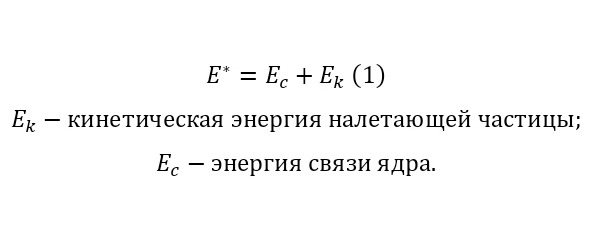
Part of the kinetic energy due to the large difference in the masses of the nucleus and the nucleon in such cases becomes equal to the kinetic energy of the bombarding nucleon. On average, the binding energy is equal to 8 MeV and can change only with the distinctive features of the composite nucleus formed in this process, but for the precisely specified target nucleus and nucleon, this value is a constant. The kinetic energy of a particle can be anything, for example, in nuclear reactions where a neutron strikes, due to the fact that there is no repulsive force of the nucleus — the Coulomb barrier, their energy can be extremely close to zero.
Thus, the kinetic energy is the minimum excitation energy of the composite nucleus.
And it is from the statement of the presence of a composite nucleus and the existence of nuclear decay channels that we can conclude about the existence of reaction channels. The reaction channels themselves are the ways of transition from an excited to an unexcited state. The type and quantum state of the incoming particles and nuclei before the start of the reaction determine the input channel of the nuclear reaction, after the completion of the reaction, the totality of the formed particles, that is, the reaction products and their quantum state is determined by the resulting output channel of the reaction. The complete characterization of the nuclear reaction is carried out by input and output channels.
The composite nucleus itself lives for quite a long time, due to which the choice of the reaction channel itself does not depend at all on the method of formation of the composite nucleus, due to which it «forgets» how it was formed. This becomes the reason for the assertion of the independence of the processes of the organization of the composite core and its disintegration. A striking example can be the situation of the formation of an excited aluminum-27 nucleus in the following ways (2).
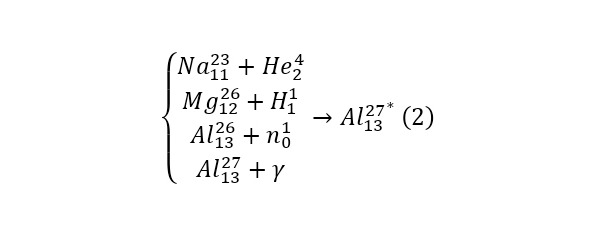
But it decays violently in the same way in all cases, provided that the excitation energy is the same. But at the same time, there is also a possibility of reverse decay of any of these reactions, with a certain probability that does not depend on the history of the origin of the excited nucleus itself. If we talk about the probability of such events, then the dependence becomes between the grade of the target nucleus and the energies.
As previously indicated, nuclear reactions can also proceed through a direct channel of interaction at high energies, since the nucleons of the nucleus can be considered as free. The difference from the previous composite core model from the direct reaction model initially consists in the distribution of the momentum vectors of the particles-products of the nuclear reaction, relative to the momentum of the bombarding particles. If spherical symmetry operates in the composite model, then in this case the geometry is simpler and the advantage in choosing the directions of the resulting particles is in the direction of the incoming particles.
Earlier, the concept of the probability of a nuclear reaction was mentioned, which is represented by a quantity called the effective cross section of a nuclear reaction. In the laboratory system of the report, the resting situation of the target nucleus is taken, the probability of interaction is determined by the product of the cross section by the flow of incident particles, while the cross section is expressed in units of area, and the flow in the number of particles crossing the unit area per unit time. The cross section of the nuclear reaction itself is calculated in extremely small units of area — barns equal to 10—24 cm2.
The ratio of reaction cases attributed to the number of particles bombarding the target is called the yield of a nuclear reaction. This value is determined experimentally by quantitative measurements, which is associated with the cross–section of reactions, and the measurement of this output is in essence the measurement of the reaction cross-section.
The laws of physics, including conservation laws, of course also apply in nuclear reactions. These laws impose certain restrictions on the possibility of carrying out a nuclear reaction itself. There are also some more specific conservation laws peculiar to the microcosm, an example of such can be the law of conservation of the baryon or lepton number. They are performed on all known reactions, but some other laws of parity conservation, isospin, strangeness, only act in fundamental interactions. The consequence of them is the selection rules that determine the real and impossible nuclear reactions that can be carried out.
The law of conservation of energy in nuclear reactions acts predictably, but very specifically for representatives of the macrocosm. In this case, the equality of the sums of the total energies (3) is fulfilled.
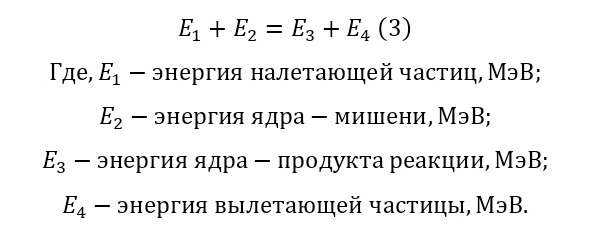
If we paint (3), then we can get (4), from which follows the reaction energy (5), which satisfies (6).
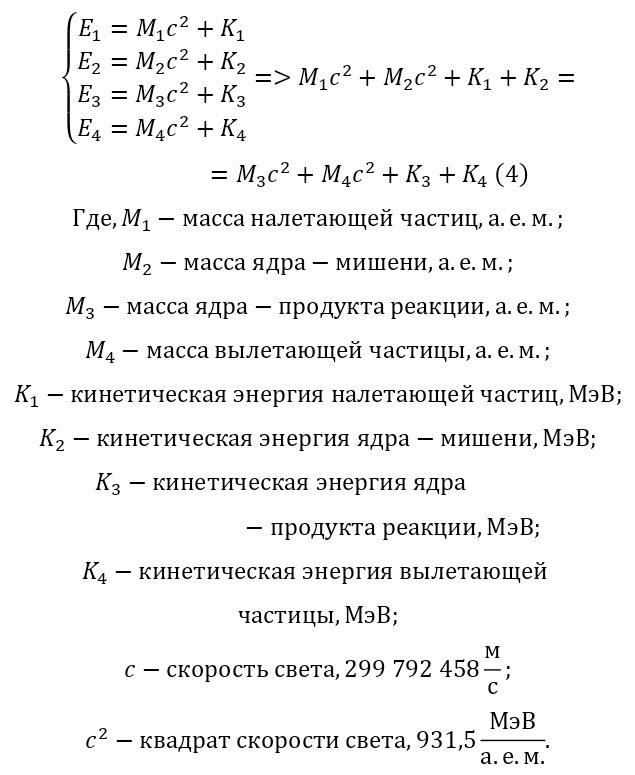

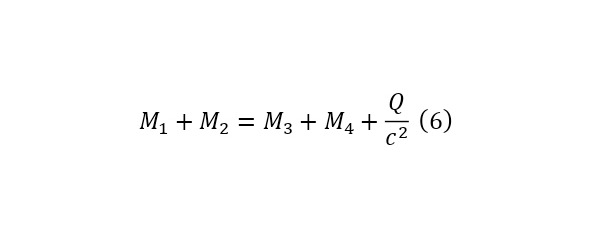
Thus (5) can also be rewritten as (7).
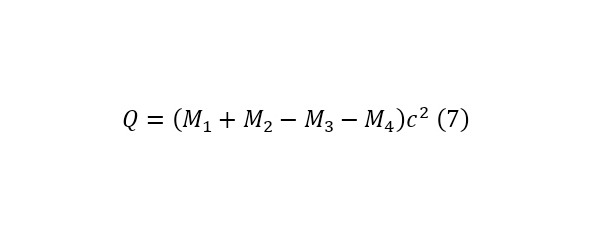
If the reaction yield is greater than zero, then this reaction is exo-energetic and is accompanied by the release of energy into the kinetic energy of the reaction products, in the opposite case — absorption and is called endo-energetic. The adjustment of such a process becomes clear both by the mass difference before and after the reaction, and with a positive difference, we can say that it turns into kinetic energy and the reaction generates energy, in the opposite case, that is, with a negative difference, the process absorbs it.
The law of conservation of momentum also applies, which is very noticeable in direct reactions (8).
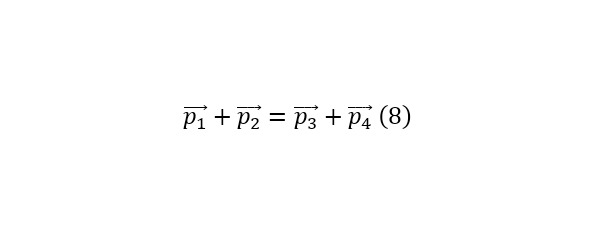
At the same time, there is a law of conservation of momentum and a number of other laws, but the most basic ones acting in the reaction are these two conservation laws.
But now it is important to focus on the types of nuclear reactions, and there are several of them: nuclear fission reaction, fusion, thermonuclear reaction and photonuclear reaction. The first type is a nuclear fission reaction, this is the process of splitting an atomic nucleus into two, and less often into three nuclei with close nuclear masses, which are called fission fragments. Other reaction products may also occur, including light nuclei — alpha particles, deuterons, as well as neutrons and gamma quanta. Fission itself is spontaneous and spontaneous, or forced, due to interaction with other particles, for example neutrons. The fission of heavy nuclei is in most cases an exo–energetic process, which makes it possible to obtain energy from radiation and kinetic energy of products from this process.
The nuclear fusion reaction is the second nuclear process, which consists in the fusion of two nuclei to form a new, heavier nucleus. This process is often accompanied by the emission of gamma rays or other elementary particles. Fusion of nuclei is most often an endo-energetic process, which most often requires the introduction of energy through the kinetic energies of particles in order to overcome the Coulomb barrier — the electrostatic repulsion of nuclei. The fusion of two nuclei and giving them energy can be realized, as it is not difficult to guess in charged particle accelerators, or these particles originally possessed this energy, for example, cosmic radiation particles, but there is another way — it is heating matter to extremely high temperatures in a special thermonuclear reactor, where the kinetic energy of particles and temperatures are extremely huge.
In this way, it is possible to approach thermonuclear reactions. In such reactions, the fusion of light nuclei leads to the conversion of the excess mass of the original nuclei into energy, since the total mass of the merged nuclei is greater than the mass of the resulting nucleus-the reaction product.
From this it can be concluded that the nuclear fusion reaction of the initial nuclei must have a relatively large kinetic energy, because they experience a rather powerful electrostatic repulsion when passing from their side of the Coulomb barrier. According to the molecular kinetic theory, their kinetic energy can be represented as the temperature of the entire substance, therefore heating will lead to an increase in the kinetic energy of the composite particles and their fusion. This is how nucleon synthesis develops in the bowels of stars with the formation of new nuclei under enormous temperatures.
In particular, the fusion reaction of protons and helium nuclei occurs in large quantities, and as a side result, other isotopes of substances are formed, including deuterium and tritium, as isotopes of hydrogen. And finally, the last type of nuclear reaction is a photonuclear reaction, in which case a gamma quantum is absorbed with sufficient energy to excite the nucleon composition, that is, the nucleus, so that it becomes composite, that is, it can be considered as such, and also releases a different structure from itself, or decays.
This process is called a photonuclear reaction or a nuclear photoelectric effect. And in conclusion, it is worth noting that nuclear reactions can be written as in the form of an equation, as demonstrated earlier, or, for example, in (9), there is also a slightly different notation (10).
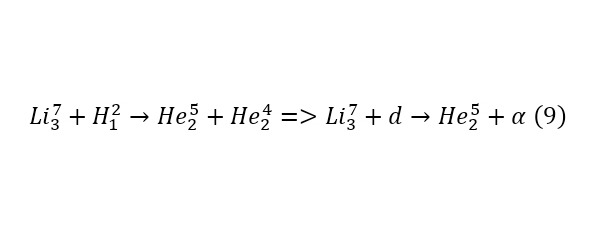
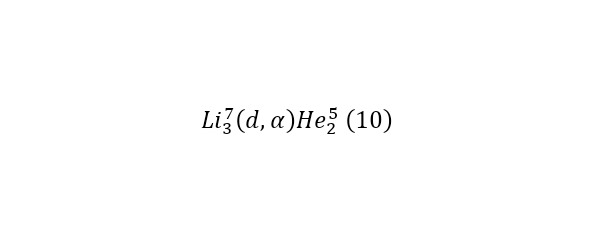
As a result, it can be concluded that it is very important for any researcher in contact with this field, including the physics of resonant nuclear reactions, to have knowledge about the nuclear reactions themselves.
And if you notice, then as it was noted, nuclear physics has been developing for a long time, not to mention the time that humanity has spent to study the structure of all matter and matter as a whole. But active research has led to the very recent discovery of a new direction in this field, namely, the physics of resonant nuclear reactions. For the first time such terminology was used and practically demonstrated in the monograph of 2021 by Aliyev I. H. and Sharofutdinova F. M. «The use of accelerators and the phenomena of collisions of elementary particles with high-order energy to generate electrical energy. The Electron Project», which later received its continuation.
2. Physics of resonant nuclear reactions
The creator of the physics of resonant nuclear reactions is I. H. Aliyev, but what is the basis of this discipline? It studies and determines the most favorable conditions for the occurrence of a kind of power surges of the products of nuclear reactions, which are called resonances. To put it simply, when a nuclear reaction takes place, it forms reaction products, which were discussed in one of the previous lectures, and all the circumstances that lead to the reaction being more efficient and their energies being greater are what the physics of resonant nuclear reactions studies.
Let’s take an example. Let charged particles be directed to the nucleus of some element, it can be protons, ions, electrons, anything. And when approaching the nucleus, the phenomenon of Coulomb repulsion occurs, it acts only on charges of the same name, namely on nuclei, but does not act on neutral particles, for example, neutrons, although the neutrons themselves also have a minimal charge. The particle spends some energy on overcoming the Coulomb barrier and remains with some of its part, which it spends on overcoming the nucleus itself and further passing the nuclear reaction.
The corresponding energy is released in the reaction, if it is endo-energetic, due to the inequality of the masses, that is, some part of the mass is converted into energy and it is already received by the products of the reaction itself — the flying particles, and they also receive the remaining part of the energy from the bombarded particle. And the total energy of these reaction products is determined by the appropriate mathematical apparatus, but we need a power jump.
Power is the product of the beam current by its energy, that is, voltage. The energy is really large for favorable reactions and is measured in MeV, but the current is extremely small. We need to somehow increase it. To do this, it is necessary to understand the phenomenon of the probability of a nuclear reaction. The beam itself is both a wave and a corpuscle, that is, a particle, according to the particle-wave dualism, which you can learn more about from the course of quantum physics, so it has its own de Broglie wavelength (1).
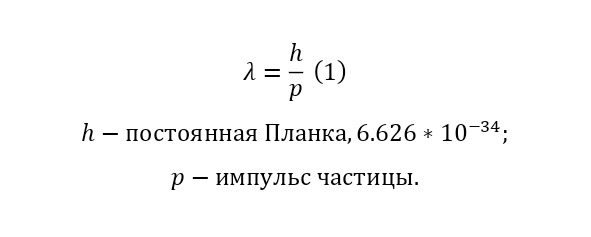
And when a particle approaches the nucleus, even if it did not hit it and did not touch it, if it is at a distance of its wavelength, then there will be an interaction. Yes, indeed, even without touching a particle, it can «hit» and enter into interaction, these are the laws of the microcosm. So, you need to increase this wavelength, and for this you need to reduce the pulse, but to reduce the pulse, you need to reduce the speed.
But it is necessary to reduce the velocity so that the particle passes the Coulomb barrier, from this we can conclude that the energy of the particle should be as close as possible to the Coulomb barrier. And here, the value of the Coulomb barrier is the resonant energy of this nuclear reaction.
Now, how to determine the output power? To do this, you need to calculate the energy, which is already easy to do, but how to determine the resonant current? To define it, imagine the following. The target plate consists of arranged atoms and let a certain number of charged particles enter inside. If we place a reference frame at the beginning of the target, then we can use the following statement that the particles will pass through some part of the target, which begins at a certain coordinate and ends at the coordinate of the sum of this coordinate and the thickness of the part itself, and the thickness is equal to the difference of these coordinates.
The question arises to this condition: how many incoming charged particles will enter into the interaction? To do this, we indicate that there are N (x) particles at the first coordinate, and dN at the end point N (x), respectively, where dN is the number of interacting charged particles.
Let’s determine the number of cores in this segment of two coordinates — x and x+dx, if the thickness between them is dx. To do this, we introduce the value of the density of nuclei, which determines the number of nuclei of a substance per unit volume, it is defined as the ratio of the density of a substance to its atomic mass in kg and changes into a nucleus / m3 (2).
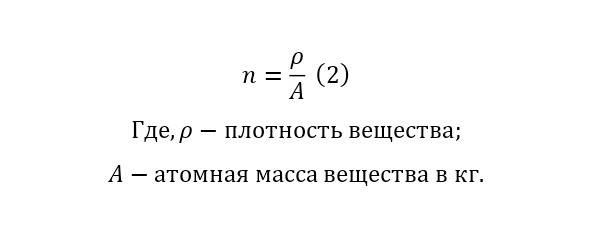
To determine how many cores there are at a specified point, it is enough to multiply this value (2) by the volume in this part of the plate, for this its area is multiplied by the thickness and by (2), which is indicated in (3).
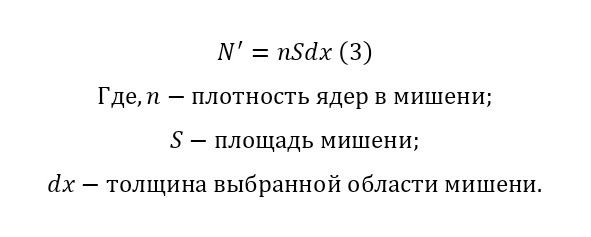
But what is the area, once in which the core will get into the interaction? For one nucleus, we introduce the concept of the nuclear effective cross section, the same region, and since the actions take place in a circle relative to the nucleus of an atom, this value is determined by (4).
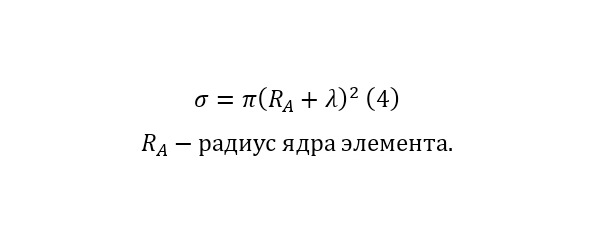
Thus, the area available for interaction is (5).
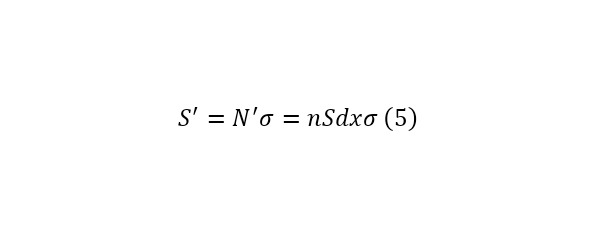
But the ratio of this area to the entire area of the plate is equal to the ratio of the number of all particles remaining without interaction to the total number of particles, that is, it is true (6).
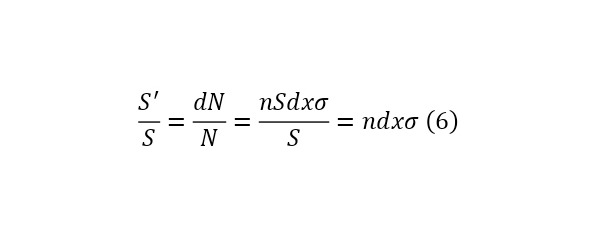
Now, we introduce a numerical definition for (6), and for this we integrate both parts (7) separately into (8) and (9), and then we get the overall result (10).
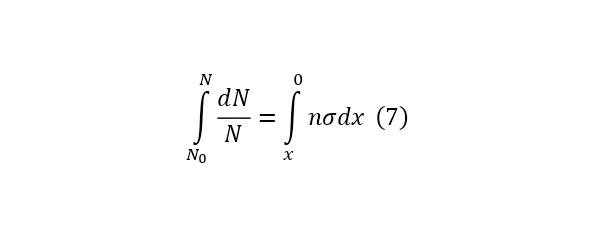
Бесплатный фрагмент закончился.
Купите книгу, чтобы продолжить чтение.